Acaena inermis purpurea (Purple Bidibid)
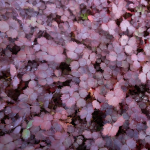
Acaena inermis purpurea, commonly called purple bidibid, has deep purple ferny leaves which intensify in colour in a sunny, open position. An easy to grow tough plant that thrives in exposed places and poor soil but demands good drainage and summer moisture. Best colour in full sun. Will tolerate and even thrive in difficult exposed situations. Very hardy non invasive groundcover. Unlike other Acaena, the inconspicuous brown seed heads don’t bear barbs or spines. Excellent in rockeries or next to grey or blue-foliaged plants. Can be planted in gravelly situations amongst rocks or paving stones to create a softer edge. Great effect when mass planted. Evergreen. Hardy.
Habitat: Found in grasslands and fellfields and along the edges of screes up to 1,600m.
Flowering: Summer [December - January]
Fruiting: Autumn [February - April]
Acca sellowiana (Feijoa)
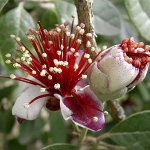
Acca sellowiana, commonly known as Pineapple Guava or Feijoa, is a small tree or shrub that is native to South America, particularly Brazil, Argentina, Paraguay, and Uruguay. It is also grown in other parts of the world, including New Zealand, Australia, and the United States.
The plant has thick, grayish-green leaves that are about 8cm long and 4cm wide. It produces showy, pink and white flowers that bloom in late spring to early summer. The flowers are followed by edible fruit that is oval-shaped, about 6cm long, and has a green, slightly rough exterior. The inside of the fruit is filled with a juicy, aromatic pulp that is white, cream-colored or pink. The pulp has a unique, sweet-tart flavor that is often described as a mix of pineapple, strawberry, and guava, which gives the plant its common names.
Acca sellowiana is a hardy plant that can tolerate a range of soil types and growing conditions, including drought and frost. It is commonly grown as an ornamental plant for its attractive foliage, flowers, and fruit. The fruit is also a popular ingredient in jams, jellies, desserts, and beverages. Acca sellowiana is the original feijoa which many of the new varieties have been bred from. Self-fertile.
Flowering: Spring [September - November]
Fruiting: Summer [December - January]
Acorus gramineus Ogon (Golden Variegated Sweet Flag)
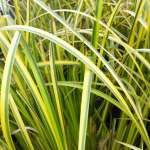
Acorus gramineus Ogon is a dwarf cultivar of grassy-leaved Sweet Flag has linear fans of semi-evergreen, glossy, pale green and yellow-striped leaves that have an overall golden effect. From spring to early summer, it bears inconspicuous yellow-green flowers that give way to tiny, reddish berries. This is an aquatic perennial with showy foliage for shallow water margins or moist rock garden. Evergreen.
Acorus gramineus Variagatus (Variegated Sweet Flag)
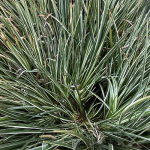
Acorus gramineus Variagatus is a variegated Sweet Flag. Its a compact, tufted semi-evergreen perennial which grows to 30cm in height, with narrow cream and green leaves. From spring to early summer, it bears inconspicuous yellow-green flowers that give way to tiny, reddish berries. This is an aquatic perennial with showy foliage for shallow water margins or moist rock garden. Evergreen.
Agapanthus orientalis Blue (Blue Flowered Agapanthus)
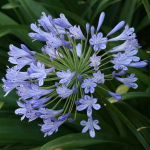
Agapanthus orientalis is a vigorous, evergreen perennial, with white fleshy roots. The broad strap-like leaves are green and glossy and grow to 60cm in length. The large clusters of tubular blue flowers are often 200mm in diameter and borne on stout stems, 60 to 90cm tall from November to February. Excellent background or focal plants which will grow almost anywhere, in full sun on dry banks or under trees in shade.
Flowering: Summer [December - February]
Fruiting: Autumn [March - May]
Agapanthus orientalis White (White Flowered Agapanthus)
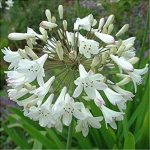
Agapanthus orientalis is a vigorous, evergreen perennial, with white fleshy roots. The broad strap-like leaves are green and glossy and grow to 60cm in length. The large clusters of tubular flowers are often 200mm in diameter and borne on stout stems, 60 to 90cm tall from November to February. In the common species the flowers are clear blue or white. Excellent background or focal plants which will grow almost anywhere, in full sun on dry banks or under trees in shade.
Flowering: Summer [December - February]
Fruiting: Autumn [March - May]
Agapanthus Seafoam
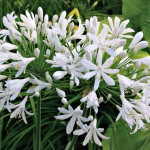
Agapanthus Seafoam is a semi-dwarf form of Agapanthus that has quite broad strap-like foliage in fresh green. In summer pretty stems of pure white flowers sit above the leaves. Looks best when planted in large drifts. Tolerant of sun or semi-shade and just about any soil type.
Flowering: Summer [December - January]
Fruiting:
Agapanthus Streamline
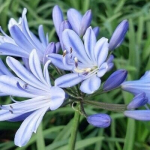
Agapanthus Streamline is an outstanding, free blooming, dwarf variety. Blue flower clusters appear in summer on long stems. Good in rockeries, amongst small shrubs as a ground cover or along a drive/footpath. Remove spent flower stems and dead leaves at the end of winter, water regulary during summer and can handle drought.
Flowering: Summer [December - January]
Fruiting:
Ajuga reptans (Bugleweed)
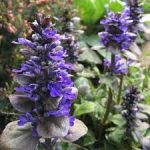
Ajuga is one of the most indispensable groundcovers around. It has many uses and looks great much of the year. Also known as carpetweed or bugleweed, ajuga forms a 0.15m tall mat of glossy leaves that always seem to look neat and fresh. Individual plants grow as a rosette, but they intertwine to form a solid carpet that withstands some foot traffic. Magnificent blue (and pink) flower spikes adorn plants spring to early summer.
Ajuga reptans is a compact, dense mat forming groundcover with glossy dark green foliage. Spreads by runners and sprouts a sea of squat blue flower stems in Spring. Good bee attractor and great for running along the front of garden borders or rockeries. Best in semi-shade.
Flowering: Spring [September - December]
Fruiting:
Anaphalioides bellidioides (Everlasting Daisy)
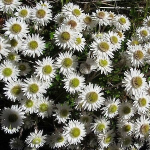
Anaphalioides bellidioides is a common perennial alpine and subalpine daisy in the Asteraceae family found throughout New Zealand, and on some offshore islands. A New Zealand native soft herbaceous densely mat-forming evergreen perennial. The flowers are white, approximately 15mm across, on stems up to about 10cm tall, and the foliage a greyish colour. Flowering occurs from mid spring to mid summer. In Marlborough they are fairly common in the Richmond Range.
Flowering: Summer [December - February]
Fruiting:
FoodSource for: Birds(I), Bees, Insects
Anemanthele lessoniana (Wind Grass, Gossamer Grass)
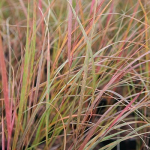
Anemanthele lessoniana, commonly known as Wind Grass, is a species of ornamental grass that is native to New Zealand. It is a perennial grass that is known for its distinctive and attractive appearance, making it a popular choice in ornamental gardens and landscapes.
Anemanthele lessoniana typically grows in clumps, with tufts of arching, narrow leaves that are about 100cm in height. The leaves are green during the growing season, but as they mature, they turn bronze or coppery in color, creating a striking display of warm hues in the garden. The leaves are thin and wiry, and they flutter and sway gracefully in the wind, giving the grass its common name, "Wind Grass".
In addition to its unique foliage, Anemanthele lessoniana produces attractive flowers in the summer months. The flowers are small, airy, and feathery, and they are typically held on tall stems that rise above the foliage. The flowers may be purplish or bronze in color, adding further interest to the overall appearance of the grass.
Anemanthele lessoniana is a hardy grass that is relatively low-maintenance. It prefers well-draining soil and is tolerant of a wide range of growing conditions, including coastal areas and exposed sites. It is also drought-tolerant once established, making it suitable for xeriscaping or water-wise gardens. Anemanthele lessoniana is typically grown as an accent plant in borders, mass plantings, or as a focal point in a garden. It is also used in dried flower arrangements, where its unique texture and color add interest and depth.
Overall, Anemanthele lessoniana is a visually appealing ornamental grass that adds a touch of elegance and movement to garden landscapes. Its unique foliage, attractive flowers, and low-maintenance nature make it a popular choice among gardeners and landscape designers alike.
Performing best when planted in full sun on a well-drained site. It is tolerant of short periods of dry, coastal conditions, frost, and cool climates, but will not tolerate prolonged wet.
Habitat: Sea level to montane forest, forest margins, scrub and on cliff faces and associated talus.
Flowering: Summer [January - March]
Fruiting: Summer [February - May]
FoodSource for: Birds(S), Bees, Insects
My Lists: Pioneer Species
Apodasmia similis (Oioi, Jointed Wire Rush)
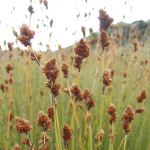
Apodasmia similis, commonly called oioi, is an attractive wetland reed with fine grey-green leaves and brownish bracts at the joints. Popular structural landscaping plant. A great option for mass planting on wet or coastal sites, growing in extremes of wind and salt.
A hardy plant tolerant of most soil types that is often used in riparian plantings. Plant communities that include Carex maorica, Carex secta, Carex virgata, Carex geminata, Phormium tenax and Eleocharis acuta often include Apodasmia similis. Recently, Apodasmia similis has become popular in landscape designs as it has an interesting texture and survives in a range of positions and is an easy NZ natives solution to wet or dry problem areas.
Habitat: Mostly coastal in estuaries, saltmarshes, dunes and sandy flats and hollows. Occasionally inland in gumland scrub, along lake margins, fringing peat bogs or surrounding hot springs.
Flowering: Spring [October - December]
Fruiting: Summer [December - March]
FoodSource for: Birds(I), Insects, Lizards
My Lists: DrainField, Erosion Control, Wetland, Pioneer Species
Aristotelia serrata (Makomako, Wineberry)
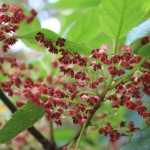
Aristotelia serrata, commonly called Makomako or Wineberry, is a fast-growing, small deciduous tree. Attractive rose-coloured flowers in spring. Deep red to black berries in summer are highly sought after by native birds. Good shade tree in sheltered areas. Frost-tender when young, however hardy once mature.
It has serrated, green leaves which may develop a purple hue, and typically grows to 5 m tall and 4 m wide. Wineberry is commonly used as a smaller specimen tree, trimmed into a hedge, or used for screening and shelter.
Best results with this tree are achieved when it is planted in full sun on a well-drained site. It will tolerate cool climates and moderate frost once established, as well as most soil conditions but only short periods of dry.
Habitat: Lowland to montane forests. Often forming dense thickets following disturbance.
Flowering: Spring [September - December]
Fruiting: Summer [November - February]
FoodSource for: Birds(F,S,N,O), Bees, Insects, Lizards
My Lists: Pioneer Species
Armeria Pink (Thrift Pink)
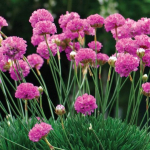
Armeria, commonly called Thrift, is a mat-forming evergreen perennial with dense, needle-like leaves and erect scapes to 15cm, bearing compact clusters of cup-shaped pink flowers in late spring and summer. Best grown in infertile, dry, well-drained soils in full sun. Good drainage is essential. Deadhead spend flower stems to encourage additional bloom.
Flowering: Spring - Summer [September - February]
Fruiting:
Armeria White (Thrift White)
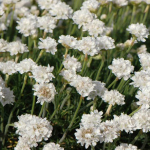
Armeria, commonly called Thrift, is a mat-forming evergreen perennial with dense, needle-like leaves and erect scapes to 15cm, bearing compact clusters of cup-shaped white flowers in late spring and summer. Best grown in infertile, dry, well-drained soils in full sun. Good drainage is essential. Deadhead spend flower stems to encourage additional bloom.
Flowering: Spring - Summer [September - February]
Fruiting:
Arthropodium cirratum (Renga Renga, Rock Lily)
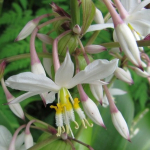
Arthropodium cirratum, commonly called Renga Renga or Rock Lily, is used widely as a ground-cover for dry shade and under trees. Forms large clumps of broad, medium-green, arching foliage. Graceful sprays of white star-shaped flowers from spring to mid-summer. Found naturally throughout NZ in coastal areas. Effective planted in groups. Tolerates coastal winds. Gets frosted back in Canterbury. Hardy.
This herbaceous perennial is grown for its foliage and flowers. It grows as a clump and bears soft and lush, dark green foliage held with a gentle arch. Masses of starry, white flowers are borne on wispy stems through spring and summer and are followed by fruits and seeds that attract birds. This plant is found naturally throughout NZ in coastal areas where it typically grows to as a tidy clump to about 75 cm tall and the same wide. It grows best when planted in full sun or partial shade on a well-drained, frost free site, though will tolerate dry and exposed conditions. The Renga Renga Lily is commonly mass planted as a groundcover, used in cottage or white gardens, included in borders, or planted around outdoor living areas.
Habitat: Found growing in dry, rocky coastal regions.
Flowering: Spring - Summer [September - December]
Fruiting: Summer [January - February]
Astelia chathamica Silver Spear (Silver Spear)
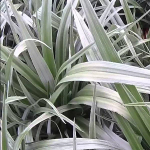
A popular flax-like plant with silvery leaves that droop at the tips and red-orange fruit in autumn. A stunning native New Zealand feature for home gardens and landscaping.
Flowering: Summer [December - January]
Fruiting: Autumn [February - April]
Astelia fragrans (Kakaha, Bush Lily)
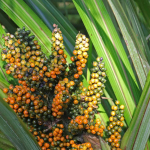 Sold Out
Sold Out
Astelia fragrans, commonly known as bush lily, bush flax or kakaha, is the most common astelia species found in New Zealand. It grows from sea level to elevations of approximately 900 metres. It has attractive broad green flax-like leaves, stiffly arched and the ribs are often reddish. It has scented flowers in Spring. When the berries mature over summer, they turn orange. Lizards feed on the berries and use the foliage to hide, making any Astelia a good addition if you want to attract lizards to your garden. Best in sheltered semi-shade.
Habitat: Kakaha occupies a range of semi-shaded, moist sheltered sites. It can be found on forest floors, cliffs, rock bluffs, lakeshore scarps and stream margins, as well as in swamps.
Flowering: Spring [October - January]
Fruiting: Summer - Autumn [January - May]
FoodSource for: Birds(F,N), Insects, Lizards
Astelia grandis (Kakaha, Swamp Astelia)
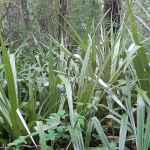 Sold Out
Sold Out
Astelia grandis, or Kakaha, is the largest of our Astelias, growing to 2m much like Harakeke. It has very broad olive green leaves with a silvery sheen beneath and reddish-purple midribs. The leaves are more erect and less tapered than A.fragrans. Forms clumps to 2m. The Female has orange berries. As a result, the female plant is a good lizard and bird attractor. These sweet juicy berries are edible even when raw.
It is an understory plant in lowland swamp forests or Kahikatea forests, but it is found mostly in the warmer areas of the South Island. Dioecious, meaning male and female plants must be grown if seed is required
Habitata: Kakaha occupies a range of moist sites. It can be found on forest floors, cliffs, rock bluffs, lakeshore scarps and stream margins, as well as in swamps. Best in sheltered semi-shade.
Flowering: Spring [September - October]
Fruiting: Summer [December - February]
Astelia nervosa (Kakaha, Mountain Astelia)
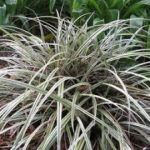
Astelia nervosa, commonly known as Mountain Astelia, is a distinctive evergreen perennial plant that is native to New Zealand. It belongs to the Asteliaceae family and is known for its striking foliage and unique form, making it a popular choice for ornamental gardens and landscapes.
The leaves of Astelia nervosa are the main feature of this plant. They are long, narrow, and sword-shaped, with a silvery-blue or grey-green color. The leaves are arranged in a clumping, basal rosette form, and can grow up to 90 centimeters in length, creating a dramatic and architectural presence in the garden.
The foliage of Astelia nervosa is typically stiff and leathery, with serrated edges, and may have a slight twist or curl, adding to its unique appearance. The silver-blue or grey-green color of the leaves provides a striking contrast against other plants in the garden and can create a bold focal point or add texture and interest to mixed plantings.
Astelia nervosa produces inconspicuous flowers that are held on tall, slender stalks that rise above the foliage. The flowers are typically small, brownish or greenish in color, and are followed by small, fleshy fruit.
Astelia nervosa is a hardy plant that is well-adapted to a range of growing conditions, although it prefers well-drained soils and partial shade to full sun. It is tolerant of coastal conditions, making it suitable for coastal gardens, and is also known to be deer-resistant.
In landscaping, Astelia nervosa is often used for its striking foliage and unique form. It can be used as a specimen plant, in mixed plantings, or in containers to create a bold and dramatic focal point. It is also well-suited for modern or contemporary gardens, as well as tropical or exotic-themed gardens.
Habitat: Found on mountainsides in forests and damp grasslands in the montane to the sub-alpine zone.
Flowering: Summer [January - February]
Fruiting: Autumn [February - May]
My Lists: Pioneer Species
Astelia nervosa Westland (Bronze Bush Flax)
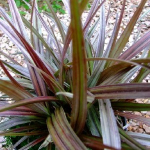
Astelia nervosa Westland with its fabulous foliage is ideal for group planting. Silvery, strap like foliage that is attractively flushed with red and bronze tones. The red colour intensifies in cold weather. Tolerant of sun or part shade but not tolerant of 'wet feet'. Astelia look their best when group planted and they are a fabulous easy care architectural container plant. Evergreen. Hardy.
Flowering: Summer [January - February]
Fruiting: Autumn [February - May]
Austroderia richardii (Toetoe)
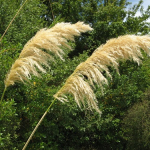
Austroderia richardii, commonly known as toetoe, is a large perennial tussock grass species that is native to New Zealand. It belongs to the family Poaceae and is endemic to the country, meaning it is found nowhere else in the world.
Austroderia richardii has distinctive features that make it easily recognizable as its one of the tallest grass species in New Zealand. The leaves are long and narrow, with a rough texture, and can grow up to 1.5 meters in length. The leaf margins are often serrated or toothed, giving them a slightly serrated appearance.
Austroderia richardii is typically found in wetland habitats, such as swamps, bogs, and riverbanks, although it can also occur in other types of habitats, including coastal dunes and forest clearings. It is an important plant for wetland ecosystems, providing habitat and food for a variety of birds, insects, and other wildlife.
Toetoe has been used by Māori, the indigenous people of New Zealand, for various purposes. The leaves have been used for weaving, thatching, and as bedding material, while the flower heads have been used for decorative purposes. Today, Austroderia richardii is also cultivated as an ornamental grass in gardens and landscaping due to its impressive size and striking appearance.
Overall, Austroderia richardii, or toetoe, is a prominent grass species in New Zealand, known for its tall stature, feathery flower heads, and importance in wetland ecosystems and cultural uses. A very tough, hardy and fast growing withstanding strong winds, costal conditions, drought and cold conditions.
On farm, Austroderia richardii is a good wind break once established as they grow in clumps and are very hardy plants that can withstand many weather conditions. Protects stock and stays below pivot irrigation, also useful in runoff prevention and along water courses. Toe toe is an attractive bank stabilisation plant, good for a range of soils and suits riparian plantings.
Habitat: Abundant, from the coast to subalpine areas. Common along stream banks, river beds, around lake margins, and in other wet places. Also found in sand dunes.
Flowering: Spring [September - November]
Fruiting: Summer [October - March]
My Lists: DrainField, Erosion Control, Wetland, Pioneer Species
Berberis Rosy Glow (Japanese Barberry)
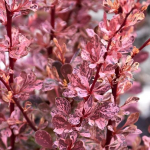 Sold Out
Sold Out
Berberis Rosy Glow is a very easy going shrub that will do well in any situation or soil. It's one of the more attractive barberries with small, rounded, reddish-purple leaves marbled with pink and white. It is dense, with a rounded shape, and loads of spines to act as a barrier to any intruders into the garden. Good choice for an informal hedge and where the bright foliage colour is needed to liven up an area.
Tiny, pale yellow flowers appear in mid-late spring, but are insignificant in comparison to the foliage. They are followed by an abundant crop of bright red berries in the fall, which are attractive to birds and often remain on the spiny stems after the leaves have fallen, therefore extending the season of interest of this ornamental shrub through the winter.
Flowering: Spring [October - November]
Fruiting: Autumn [March - May]
Brachyglottis greyi (Brighteyes, Resin Bush)
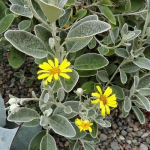
Brachyglottis greyi is a spreading shrub with daisy-like golden blooms during summer. Silver-edged grey leaves make great contrast. Excellent ground cover plant for a sunny, well-drained site. Rare small shrub inhabiting rocky sites of the southern North Island. Evergreen.
Habitat: Primarily a coastal species on rock outcrops and bluffs but may extend inland up river gorges and in suitably exposed bluff habitats. Confined to the southern North Island from near Flat Point south to the mouth of the Orongorongo River.
Flowering: Summer [December - March]
Fruiting: Autumn [March - April]
Brachyglottis monroi (Monros Groundsel)
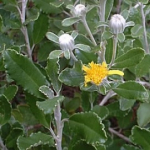
Brachyglottis monroi, commonly called Monros Groundsel, is a neat compact low spreading shrub with leaves a green to brownish-green above and whitish below. The margins of the leaves are distinctly crinkled. Superb plant in any landscape. Clusters of bright yellow flowers in summer. Hardy will grow in sun or shade, and tolerant of dry conditions. Evergreen. Hardy.
Habitat: Found in subalpine scrub among the Kaikoura Ranges.
Flowering: Summer [December - March]
Fruiting: Autumn [March - April]
Buxus Green Gem (Dwarf Box Hedge)
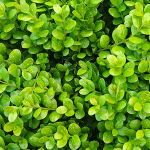
Buxus Green Gem is a slow-growing compact form of Buxus, with a naturally rounded shape. “Green Gem” is ideal for topiary, trimming into a formal hedge, maintaining in a container, or including in a mixed planting. Easy to grow in sun or part shade. Greater resistance to Buxus blight than Buxus sempervirens. Evergreen Hardy.
Flowering: Spring [October - December]
Fruiting: Summer [December - March]
Buxus sempervirens (Box Hedge, English Box)
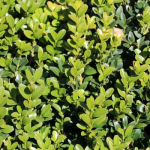
Buxus sempervirens, commonly called Box Hedge or English Box, is a bushy evergreen shrub with lush green foliage. Its valued for topiary hedging as it tolerates close shearing. A must for the formal garden. Plant them 20cm apart for a low tightly clipped formal hedge. Evergreen. Frost hardy.
The common box, European box, or boxwood, is a species of flowering plant in the genus Buxus, native to western and southern Europe, northwest Africa, and southwest Asia, from southern England south to northern Morocco, and east through the northern Mediterranean region to Turkey.
Habitat: The species typically grows on soils derived from chalk, limestone, usually as an understorey in forests of larger trees, most commonly associated with European beech (Fagus sylvatica) forests, but also sometimes in open dry montane scrub, particularly in the Mediterranean region. Box Hill, Surrey is named after its notable box population, which comprises the largest area of native box woodland in England.
Flowering: Spring [October - December]
Fruiting: Summer [December - March]
Buxus sempervirens Variegata (Variegated Box)
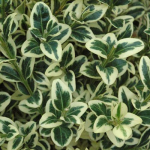
Buxus sempervirens Variegata, or Variegated Box, is a variety of box that has an upright, vigorous habit. The dark green leaves are margined gold to yellow. Box is one of the finest plants for creating a formal hedge and is extensively used in topiary work. Evergreen. Hardy.
Flowering: Spring [October - December]
Fruiting: Summer [December - March]
Carex buchananii (Buchanan)
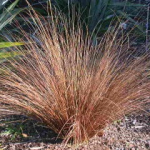
Carex buchananii is a 60 cm tall native hair sedge which forms upright clumps of very fine, hair-like leaves of a bronzy-cinnamon colour. The stiff blades curve at the end. Looks fabulous planted in large drifts. Hardy to just about any conditions but happiest in a sunny position that does not dry out completely in summer. Evergreen. Hardy.
Habitat: Coastal to montane (up to 1000 m a.s.l.). On beaches, lagoon, lake and stream margins, or in damp ground within open forest or short tussock grassland.
Flowering: Spring [October - December]
Fruiting: Summer - Autumn [November - June]
My Lists: Pioneer Species
Carex comans (Sedge)
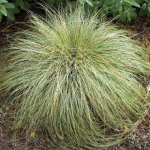
Carex comans, commonly known as New Zealand Hair Sedge or Tussock Sedge, is a species of grass-like plant that belongs to the Cyperaceae family. It is native to New Zealand and is known for its distinctive tussock-forming growth habit, which makes it a popular choice for ornamental landscaping in many regions.
The Carex comans plant typically forms dense tufts of fine, slender leaves that are usually green or brownish-green in color. The leaves are narrow, linear, and typically have a drooping or arching appearance, reaching up to 60 cm in height. The leaves are soft and flexible, giving the plant a graceful, delicate appearance.
The inflorescence of Carex comans consists of small flowers that are typically inconspicuous and often hidden among the leaves. The flowers are usually brown or greenish-brown in color and are arranged in clusters or spikes at the tips of long stalks that rise above the leaves. The flowers are followed by small, triangular fruits that contain the plant's seeds.
Carex comans is a hardy and adaptable plant that can tolerate a wide range of growing conditions. It prefers well-drained soils and can tolerate both full sun and partial shade, although it generally performs best in partial shade in warmer climates. It is commonly used in rock gardens, borders, and as a ground cover, and is often planted in mass for its ornamental value. Evergreen. Hardy.
Habitat: Coastal to subalpine. Usually in free draining soils either in the open or under scrub or tall forest in relatively open sparsely vegetated situations. It often naturalises in urban areas.
Flowering: [Throughout the year]
Fruiting: [Throughout the year]
Carex dipsacea (Teasel Sedge)
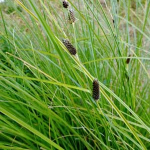 Sold Out
Sold Out
Carex dipsacea, commonly called Teasel Sedge, is an attractive coarse green grass with narrow foliage that can develop strong bronze tones. Summer seed-heads of dark brown. Will grow happily in moist damp conditions in sun or shade. Hardy to both wind and frost. Tough and robust, great for mass planting in difficult spots. Carex dipsacea is an important plant species for wildlife, as it provides habitat and food for various insects and birds. It is also used in horticulture for its ornamental value, as it adds texture and form to garden settings. Evergreen. Hardy.
Habitat: Coastal to subalpine. Favouring wetlands this species usually grows along rivers, lakes and ponds within sand dunes, tall forest, shrubland, and tussock grassland.
Flowering: Spring [October - December]
Fruiting: Summer [December - February]
Carex flagellifera (Glen Murray Tussock)
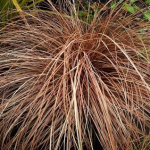
Carex flagellifera is a densely tufted sedge growing up to 50 cm high, very similar to C. testaceae and differing largely in its colour, ranging from shiny green to bronze with brownish shades. Evergreen. Hardy.
Habitat: Coastal to montane. Usually in free draining soils under scrub or open forest. Rarely in wetlands or in permanently damp, shaded sites.
Flowering: Spring [September - November]
Fruiting: Summer [December - February]
My Lists: Pioneer Species
Carex secta (Pukio, Swamp Sedge)
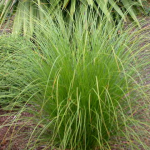
Carex secta, commonly called Swamp Sedge or Pukio, is a well known species and it is a most useful plant for use in re-establishing or enhancing wetland areas. Common to swampy areas and in standing water and it is a most useful plant for use in enhancing wetlands and ponds. Older plants in moist to wet sites, often form thick trunk-like bases 1 metre tall from its own tightly matted roots. It takes on a yellow-green colour in open situations with the colour being intensified in the Winter. Attractive dark brown seed heads in summer. Great for bank stabilisation and riparian planting.
Endemic to New Zealand, found throughout the country. Carex secta is riparian species. It is often found in plant communities that include but are not limited to Apodasmia similis, Carex maorica, Carex virgata, Phormium tenax, and Eleocharis acuta.
Habitat: Widespread in suitable wetlands from coastal to montane wetlands.
Flowering: Summer [October - January]
Fruiting: Autumn [October - March]
My Lists: DrainField, Erosion Control, Wetland, Pioneer Species
Carex testacea (Speckled Sedge, Orange Sedge)
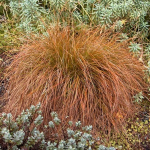
Carex testacea, commonly known as Orange or Speckled Sedge, is a clump-forming perennial grass-like plant that belongs to the family Cyperaceae. It is native to New Zealand and is widely cultivated as an ornamental plant in many parts of the world.
Carex testacea is known for its distinctive foliage, which undergoes color changes throughout the year. The leaves are typically narrow and linear, and they emerge in shades of green, gradually turning to a warm bronze, copper, or orange color as they mature. The foliage has a fine, hair-like texture, which gives the plant a unique and ornamental appearance.
The plant typically grows in dense tufts or clumps, with stems that are typically upright or slightly arching, reaching a height of 30 to 60 cm. The stems are usually smooth and glossy, and they may develop a reddish coloration towards the base.
Carex testacea is a relatively low-maintenance plant that is tolerant of a wide range of growing conditions. It prefers well-draining soils and can tolerate partial to full sun, although it may exhibit more intense coloration in brighter light. It is drought-tolerant once established, making it suitable for water-wise gardens. Evergreen. Hardy.
Habitat: Coastal to montane. In sand dunes, coastal forest and scrub, dense forest or short tussock (Festuca novae-zelandiae) grassland.
Flowering: Spring [September - December]
Fruiting: Summer [December - May]
My Lists: Pioneer Species
Carex virgata (Pukio, Swamp Sedge)
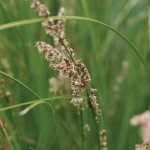
Carex virgata, commonly called Swamp Sedge or Pukio, is a vigorous sedge suitable for swamps, drain margins, seepages and wet pastures. A successful colonising plant, used for wetland planting and revegetation. Suitable for conditions which may vary periodically from very wet to very dry. More dry tolerant and shorter than C. secta. Evergreen. Hardy.
It pairs well with Carex secta (also called Pukio) for bank stabilisation. As it handles being in a swampy area, it is ideal for lower bank planting in riparian revegetation projects. It is also useful in water treatment projects as it minimises nutrient runoff. This makes it ideal for planting streamside on farms.
Carex virgata is widespread in open, swampy conditions and also in damp sites within lowland forest. In parts of the country this sedge is often the dominant carice of lowland alluvial forest. Found in communities that include but are not limited to Apodasmia similis, Carex maorica, Carex secta, Phormium tenax, and Eleocharis acuta.
Habitat: Widespread from sea level to about 1000 m a.s.l. in open, swampy conditions and also in damp sites within lowland forest. In parts of the country this sedge is often the dominant carice of lowland alluvial forest.
Flowering: Spring [October - December]
Fruiting: Summer [December - May]
My Lists: DrainField, Wetland
Carmichaelia australis (Makaka, Common Broom)
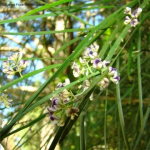
Carmichaelia australis, commonly called Common Broom or Makaka, is a small to large shrub with spreading erect and flattened to round photosynthetic stems. Meaning that instead of leaves the stems are flattened to catch the sunlight. It is a hardy fast growing upright broom. From spring through to summer, it has small 5-6 mm white flowers with purple veins and sometimes has purple centres. The seeds are yellow, orange or red often with black dots. The seeds are distributed when the seedpod bursts so the seed travels only short distances, compared to wind and bird-dispersed seed. Attractive to bees. Evergreen. Prefers full sun and tolerates dry, windy and cold sites. Hardy.
Habitat: Coastal to montane, on river terraces, stream banks, colluvium, rock outcrops, talus and fan toe slopes, among tussock grassland and grey scrub, on the edge and margins of dense bush, forest, and in swamps.
Flowering: Spring - Summer [October - February]
Fruiting: Summer - Autumn [November - May]
Cassinia vauvilliersii (Mountain Tauhinu, Cottonwood)
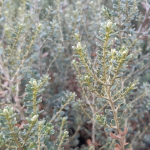
Cassinia vauvilliersii, commonly called Mountain Tauhinu or Cottonwood, is a bushy shrub with small silver green leaves with fine silver hair beneath. The stems silver/white in colour. It has an attractive silver-grey appearance and flowers in profusion with clusters of tiny cream daisy (wheel-shaped) flowers followed by down-covered seed heads.
Habitat: Lowland to montane or lower subalpine shrubland and grassland.
Flowering: Summer [December - March]
Fruiting: Autumn [March - April]
Ceanothus prostrata (Californian Lilac)
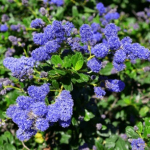
Compact spreading bush with mass clusters of dark-blue flowers in late spring. Very dark foliage. Flourishes in tough conditions with minimum watering and full sun. Perfect for mass planting and weed suppressing ground cover. Evergreen. Hardy.
Flowering: Spring - Summer [September - January]
Fruiting:
Chamaecyparis pisifera Boulevard (Sawara Cypress)
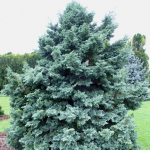
Chamaecyparis pisifera Boulevard is an attractive, semi-dwarf, evergreen conifer with a dense, upright and broadly pyramidal growth habit. It is a conical grower with soft, silvery blue-green awl-shaped leaves which are not prickly but curve nicely to a fine point along the compact branches.
Chamaecytisus palmensis (Tree Lucerne, Tagasaste)
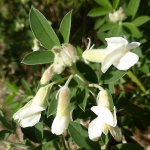
Tree Lucerne is a small, fast-growing tree, great for stock fodder, firewood or shelter. Attracts wood pigeons during winter and spring when it's in flower as well as bees attracted by the flowers too. It's also nitrogen fixing, drought tolerant and controls erosion with its deep roots. One of the best trees to attract tui and other native birds to your garden. Nurse crop for natives. Withstands drought/wind. Evergreen. Frost tender when young.
Habitat: Dry places, river beds, coastal sites, hillsides.
Flowering: Winter - Spring [May - October]
Fruiting:
My Lists: Winter Pollen
Chionochloa flavescens (Broad-leaved Snow Tussock)
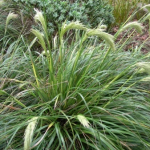
Chionochloa flavescens, commonly known as Snow Grass or Haumata, is grown for its foliage, golden tassels, and hardiness. It grows as a clump to about 1.5 m high and the same wide bearing narrow, green leaves with a graceful arch. Chionochloa flavescens is a hardy grass that is commonly planted alongside water, mass planted under trees, or individually in rock gardens, or used to line a walkway or driveway. Smaller than the South Island Toetoe Austroderia richardii plus handles drier conditions.
Habitat:
Flowering: Summer [December - February]
Fruiting:
My Lists: Pioneer Species
Chionochloa rubra (Red Tussock)
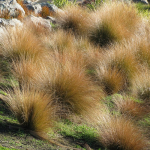
Chionochloa rubra, commonly known as Red Tussock grass, is a species of tussock that is native to New Zealand. It is a perennial grass that belongs to the Poaceae family and is known for its distinctive appearance and ecological importance.
Chionochloa rubra forms large, dense tussocks that can reach heights of up to 1.5 meters tall, although some specimens can grow taller in favorable conditions. The leaves are long, narrow, and stiff, with leaf edges are often rolled inward, giving them a tubular appearance. The tussocks are often reddish-brown at the base, which gives the species its common name "red tussock."
Chionochloa rubra plays a vital ecological role in New Zealand's ecosystems. The dense tussocks provide shelter and nesting sites for native birds. The tussocks also help prevent erosion by stabilizing soil with their extensive root systems, and they can trap and store snow, which helps regulate water flow in alpine catchments. Additionally, Chionochloa rubra is an important food source for native insects and other herbivores, and it contributes to nutrient cycling in the ecosystem.
Red tussock is a most adaptable vegetation which will grow in the exposed and windy environment. It can tolerate low-nutritious, and also can grow in relatively wet or dry soil conditions. It is harsh enough to use one individual specimen plant however, if space allowed, would be better for planted several as a group. Red tussock is a useful vegetation for helping to reestablish wildlife habitat, especially useful as a buffer plant around wetland areas.
Habitat: Subalpine to alpine (rarely upper montane). Often the dominant of tussock grassland, also found within shallow bogs or fringing the margins of deeper bogs and small ponds, tarns and slow flowing streams. Occasionally in canopy gaps in upper montane forest or within subalpine scrub.
Flowering: Spring [October - December]
Fruiting: Summer [November - May]
My Lists: DrainField, Erosion Control, Pioneer Species
Choisya ternata (Mexican Orange Blossom)
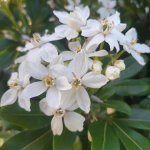
Choisya ternata, commonly called Mexican Orange Blossom is a hardy, evergreen shrub with glossy dark green fragrant foliage and has a dense habit maintaining a natural rounded shape. Choisya ternata produces clusters of pure white flowers lasting months throughout spring, summer and autumn. It is happy growing in sun or shade and alongside many other plants preferring an open free draining soil. Fantastic for hedging or as a gap-filler in the garden. Hardy.
Flowering: Spring - Summer [September - November]
Fruiting:
Cistus Bennetts White (Rock Rose)
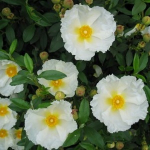 Sold Out
Sold Out
Cistus Bennett's White, or Rock Rose, is a fabulous shrub for hot, dry or coastal conditions. The coarse green foliage and large papery white flowers with their bright yellow centres make a real show from spring through to summer. Benefits from a trim after flowering.
Flowering: Spring - Summer [September - February]
Fruiting:
Cistus Brilliancy (Rock Rose)
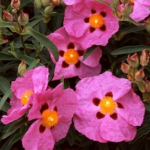 Sold Out
Sold Out
Cistus Brilliancy, Rock Rose, makes a 'Brilliant' show in summer when the aromatic foliage is smothered with rich rosy pink flowers with deep maroon markings and yellow centers. Hardy to most conditions. Great for hot dry spots. Very reliable. Prune lightly after flowering to maintain shape.
Flowering: Spring - Summer [September - February]
Fruiting:
Cistus Sunset (Rock Rose)
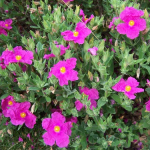 Sold Out
Sold Out
Cistus Sunset, or Rock Rose, is a superb little shrub for those hot dry spots in the garden. The aromatic grey leaves are decorated with hot rose pink flowers off and on throughout the year. Loves warmth and needs a well drained spot. Benefits from a trim every now and then.
Flowering: Spring - Summer [September - February]
Fruiting:
Clematis paniculata (Puawananga)
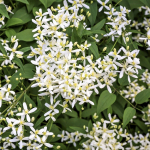 Sold Out
Sold Out
Clematis paniculata, or Puawananga, is an attractive climber with masses of white flowers in spring. The plant does best when planted in a moist but well-drained soil with roots in a cool shady place and the foliage is going to be in the sun.
Clematis paniculata is a vigorous grower and can reach a height of up to 20 feet (6 meters) or more, depending on the growing conditions. It prefers a sunny to partially shaded location and in well-drained, fertile soil. It is a versatile plant that can be grown on trellises, arbors, fences, or allowed to scramble over shrubs and trees. It is relatively low-maintenance, requiring regular watering and pruning to promote healthy growth and abundant flowering.
Habitat: Coastal to montane in shrubland or tall forest (up to 1000 m a.s.l.).
Flowering: Winter - Summer [July - October]
Fruiting: Summer [November - January]
Coleonema Sunset Gold (Breath of Heaven)
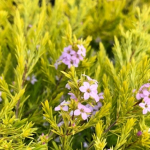
Coleonema Sunset Gold, commonly called Breath of Heaven, has bright golden yellow foliage all year round, which may change to a lime-yellow in the winter months. In spring masses of pale pink flowers appear. Its low growth habit gives good coverage over your garden. This is one of the best foliage plants you can choose for the garden. It will happily grow with many other plant types and looks stunning planted in a group or on its own. Plant in full sun for best foliage colour. Evergreen. Semi hardy.
Flowering: Spring [September - November]
Fruiting:
Convolvulus cneorum (Silverbush)
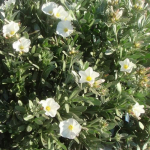
Convolvulus cneorum is a prolific flowering, low growing shrub. The clean silver foliage covers the plant all year round and the cup shaped white flowers open in late spring and continue throughout the summer and autumn months.
Convolvulus cneorum needs a sunny free draining position preferring full sun. Protect from severe frosts in the first season. It is a perfect plant for small hedges or garden borders and looks great in a decorative pot, Convolvulus cneorum is a very good general garden plant.
Flowering: Spring - Autumn [October - March]
Fruiting:
Coprosma acerosa (Tataraheke, Sand Coprosma)
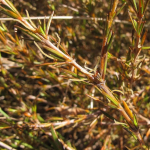
Coprosma acerosa, or sand coprosma, is a groundcover that is found naturally near the coast throughout New Zealand. Great for windy, coastal areas which get dry winds. The small needle-like deep green leaves clothe the intertangling branches that form springy mounds with a spread of up to 1m. Useful grown in areas prone to erosion, on banks, or over walls. Can also be easily incorporated into mixed shrub planting as a ground cover. In addition to bank stabilisation and as a mixed groundcover, native gecko species love the berries. As a result, this is a good addition to a revegetation project looking to increase biodiversity in the area. When plants of both sexes are present, attractive smoky blue berries follow the tiny green flowers. This is an excellent plant for coastal areas and hot dry conditions.
Habitat: Coastal sand dunes.
Flowering: Spring [September - December]
Fruiting: Autumn [February - May]
My Lists: Erosion Control
Coprosma areolata (Thin Leaved Coprosma)
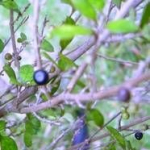
Coprosma areolata grows as a divaricating shrub or small tree to 3m, usually erect in habit. The pale green leaves are small and thin, hence the common name Thin Leaved Coprosma. It produces blue or black berries which the birds can eat. Grows in wet, lowland forest and can also grow in exposed places.
Habitat: Lowland to lower montane forest.
Flowering: Spring [October - December]
Fruiting: Summer [January - March]
Coprosma Beatsons Gold
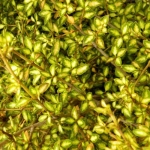
Coprosma Beatson's Gold is a compact rounded shrub with small foliage that are variegated green and yellow. Hardy evergreen that tolerates coastal conditions and frosts. Likes full sun and may be grown as a feature plant, hedging or as a groundcover. Insignificant, pale green flowers in spring are followed by bright red fruit in autumn. Can be trimmed to shape.
Flowering: Spring [September - November]
Fruiting: Autumn [March - May]
Coprosma Black Cloud
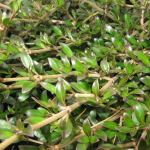
Coprosma Black Cloud is a low growing, evergreen shrub renowned for its dark foliage. The tiny leaves on this NZ native are black-bronze and held densely on rigid stems. It grows with a tidy, rounded habit to about 40 cm tall and 1.0 m wide, giving the strongest leaf colourings when planted in full sun on a well-drained site. It will also grow well in partial shade but tends to lose its denseness and colouring will be lighter. It is also tolerant of dry periods, frost, cold climates, wind, and coastal conditions. Black Cloud is commonly added to a mixed planting, used as a groundcover, included in borders, or mass planted on a bank. Excellent for supressing weeds.
Flowering: Spring [September - November]
Fruiting: Autumn [March - May]
Coprosma brunnea (Brown Stemmed Coprosma)
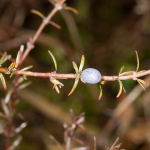
Coprosma brunnea is one of 45 species of Genus Coprosma that are found in New Zealand. A hardy wiry shrubby groundcover that is very tough and suitable for harsh conditions. Dense and bushy with attractive chocolate brown coloured foliage, grows tight and covers well. Ideal for trimming and mass planting on banks and swales, or sprawling down steep hill faces. Very small flowers develop from August to October among the branches and the female plant, in January, develop 5-6 mm long drupes which are a translucent sky-blue or are translucent white with blue flecks.
They also provide habitat for New Zealand’s declining lizard and gecko populations. As attractors of these small animals, they are a pioneer shrub in revegetation projects. Mingimingi provides a tough shelter, providing good food for native birds and lizards, as well as ground cover for these. Hardier the C. acerosa.
Coprosma species have small unisexual flowers that are borne on different plants (dioecious) and they have a fleshy fruit (drupe).
Habitat: Plains to subalpine. Coprosma brunnea grows in lowland to higher montane river beds up to 1500m in open grassland and rocky places on the South and Stewart Islands of New Zealand.
Flowering: Spring [August - December]
Fruiting: Summer - Autumn [January - June]
My Lists: DrainField, Erosion Control, Pioneer Species
Coprosma Copper Shine (Mirror Bush)
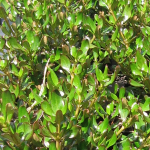 Sold Out
Sold Out
Coprosma Copper Shine is tough and hardy evergreen shrub has gorgeous foliage with round, glossy leaves that are tipped with copper tones year-round for attractive garden contrast. Growing 1 - 2 metres high and wide, the density of the foliage lends extremely well to hedging, screening and windbreaks. Perfect for coastal gardens, mixed beds, and container planting. Tolerates dryness. Evergreen.
Coprosma crassifolia (Mingimingi)
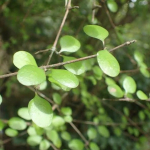
Coprosma crassifolia, commonly called mingimingi, is a stiffly-branched upright shrub with small dark-green leaves and white to pale-yellow berries that attract skinks and birds. It's a tough shelter and revegetation shrub for drought-prone sites. The upright, columnar habit is good for narrow spaces.
In the forest, the shrub is sparsely branched but in the open, it forms densely branched thickets. The stiff, more or less round remote leaves and the stiff, red-brown branchlets distinguish C. crassifolia from all other Coprosma species. The flowers are unisexual. The berries flesh is transparent but look white due to the white seed within. They may also look pale yellow.
Habitat: Coastal rocky and sandy lowland to lower montane shrubland and forest, up to 600 m.
Flowering: Spring [September - October]
Fruiting: Summer - Autumn [November - June]
Coprosma Hawera
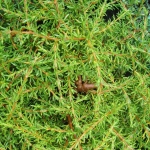
Coprosma Hawera is a NZ native shrub that grows naturally in coastal locations. It grows as a tightly tangled mound of small, orange stems bearing small, green leaves. This evergreen is fast growing and requires only the odd trim to encourage fresh, new growth. It grows as a mound to about 20 cm tall and 1.0 m wide, performing best when grown in full sun or partial shade on a well-drained site. It tolerates dry periods, frost, wind, coastal conditions, and will grow well in almost any location that has good drainage. Hawera is commonly mass planted either as a groundcover or on a bank, included in rock or coastal gardens, or planted along the edge of a wall or path where it can to spill over the edge.
Coprosma Kirkii (Groundcover Coprosma)
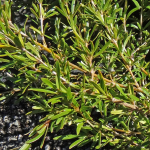
Coprosma Kirkii is a dense, vigorous, sprawling shrub with small, glossy mid-green leaves. Used extensively for bank stabilising, coastal planting and as a fast groundcover. Suitable for erosion control especially on coastal sites. Evergreen. Hardy.
My Lists: DrainField, Erosion Control
Coprosma linariifolia (Mikimiki, Yellow Wood)
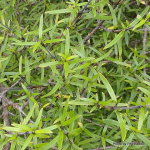 Sold Out
Sold Out
Coprosma linariifolia, commonly called mikimiki or yellow wood, is a shrub or small tree that is native to New Zealand. It has small narrow leaves and yellow wood (under the bark).
Habitat: Coprosma linariifolia is found in lowland to montane forest and scrub from the central North Island to the bottom of the South Island. Hardy
Flowering: Summer [December - February]
Fruiting: Autumn [January - April]
Coprosma Lobster (Needle-leaved Mountain Coprosma)
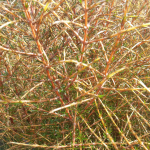
Coprosma Lobster is an attractive variant of Coprosma rugosa. An extremely tough native shrub with interesting texture. Foliage is a vibrant red with a mass of interwoven branches. Excellent for mass planting and low hedges. Thrives in sun or part shade. Evergreen. Hardy.
Flowering: Summer [October - November]
Fruiting: Autumn [February - April]
Coprosma lucida (Shining Karamu)
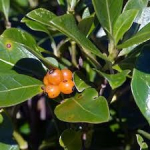 Sold Out
Sold Out
Coprosma lucida is endemic and commonly known as shining karamu. It is a small tree that is ideal for coastal projects. It can survive in many climates, but is most commonly found in coastal areas, lowland forests, or shrublands. It performs best where it can derive sufficient moisture and some shade, although it is tolerant of challenging locations such as coastal shrubland. Its wide, bright green leaves are thick, smooth, and shiny.
As with other Coprosma species, their berries are ideal for attracting birds, especially bellbirds, tuis and waxeye.
Habitat: Coastal and lowland forests or shrublands.
Flowering: Spring [August - December]
Fruiting: Summer [January - June]
Coprosma Pride
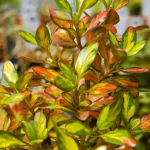
Coprosma Pride is a compact dense shrub with neat habit. Glossy small multi-coloured leaf of green with splashes of yellow and orange. Can be clipped for a perfect hedge. Prefers a full sun position for best colour, but will tolerate partial shade. Suitable for most soil types as long as they’re well drained. Easy to grow and suitable for coastal planting.
Coprosma propinqua (Mingimingi)
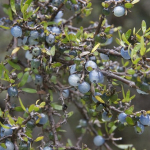
Coprosma propinqua, commonly known as Mingimingi, is a species of evergreen shrub or small tree that is native to New Zealand. It belongs to the family Rubiaceae and is known for its distinctive foliage and attractive appearance.
Coprosma propinqua exhibits a compact and bushy growth habit, typically reaching a height of 1 to 3 meters. The leaves are opposite, simple, and small, measuring about 1 to 3 centimeters in length. The leaves are elliptical or lanceolate in shape, with smooth margins, and are usually glossy and dark green in color. Some varieties may have variegated leaves with contrasting colors, such as yellow or cream markings.
The flowers of Coprosma propinqua are small and inconspicuous, typically greenish or yellowish in color. They are borne in clusters and are not particularly showy. The plant is dioecious, which means that male and female flowers are borne on separate plants.
The fruit of Coprosma propinqua is a fleshy drupe, typically spherical or ovoid in shape, and about 5 to 7 millimeters in diameter. The fruit initially appears green, but matures to a dark purple or black color when ripe. The fruit is often eaten by birds, which help to disperse the seeds.
Coprosma propinqua is commonly found in various habitats in New Zealand, including forests, shrublands, and coastal areas. It is known for its ability to tolerate a wide range of growing conditions, including poor soils and exposure to salt spray, making it a hardy and adaptable plant. It is also known to have medicinal properties and has been used traditionally by Maori for various purposes.
In cultivation, Coprosma propinqua is often used as an ornamental plant in gardens and landscapes due to its attractive foliage and low maintenance requirements. It can be grown as a standalone specimen plant, or used as a hedge or ground cover. It is typically propagated by seeds or cuttings, and prefers well-drained soils and a sunny to partly shaded location.
Habitat: Found in lowland forest, along forest margins and streambanks, in scrub, gravelly places and along the edges of bogs and swamps.
Flowering: Spring [October - December]
Fruiting: Autumn [January - April]
My Lists: DrainField, Wetland, Pioneer Species
Coprosma Red Rocks (Groundcover Coprosma)
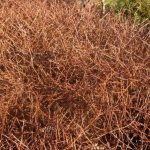
Coprosma Red Rocks is a divaricating native plant with small needle-like orange-red foliage, is found naturally near coastlines throughout N.Z. The colour intensifies with colder temperatures. An excellent groundcover plant for hot, dry conditions, on banks or as under planting. Very tolerant of wind, salt and dry periods. Hardy.
Flowering: Spring [September - November]
Fruiting: Autumn [March - May]
Coprosma rhamnoides (Red-fruited Coprosma)
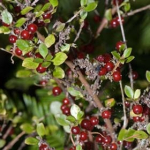
Coprosma rhamnoides is a dense tightly divaricating shrub. Tiny light green leaves. Stiff red/brown branches. Good for exposed, dry areas. N.Z. flora has a large number of shrubs with small tough leaves and wiry interlacing branches – divaricates. Some even have brown or grey new growth, giving a dead-like unattractive appearance. It is suggested that this may be a defensive growth mechanism to deter visits from browsing moa. Coprosma rhamnoides is a good example.
In October the plants develop small pale cream flowers which are dioecious (sexes separate). These flowers are wind pollinated. Drupes appear on the female plant in March-April small (3-4mm) red berries, turning dark red or black as they ripen.
Habitat: It is widespread in Canterbury and Westland in lowland to lower montane-scrubland and forest mostly as an understorey plant. It is less common higher in the montane zone.
Flowering: Spring [October - November]
Fruiting: Autumn [March - April]
Coprosma robusta (Karamu)
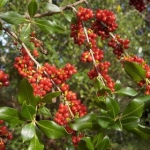
Coprosma robusta, Karamu, is a fast-growing shelter, hedging and nurse plant. Competes well with gorse. Laden with bright-orange fruit/seeds March-July. As with other Coprosma species, their berries are ideal for attracting birds, especially bellbirds, tuis and waxeye. This is one of the many reasons why Coprosma robusta is a pioneer revegetation species. Its wide, bright green leaves are thick, smooth, and shiny. Can be confused with C. lucida. Shade tolerant. Suits low-frost sites. Evergreen.
History of use: Karamū is used for a variety of purposes in human culture. The fruit that Coprosma robusta produces can be eaten, and the shoots of Karamū are sometimes used for medical purposes.
Habitat: Common throughout coastal, lowland and lower montane habitats within shrublands and open sites within forest.
Flowering: Spring [August - November]
Fruiting: Autumn [March - August]
My Lists: Erosion Control, Pioneer Species
Coprosma rotundifolia (Round-leaved Coprosma)
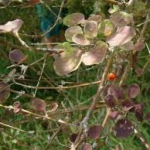
Coprosma rotundifolia is an attractive upright shrub with soft, thin, quite rounded pale-green and purple-blotched leaves with interlaced branches. Rather slender shrub up to 2-4 m tall; branches spreading to divaricate that does well in dappled light. Coprosma rotundifolia is superficially similar to and most often confused with C. rubra. Coprosma rubra differs from the much more widespread C. rotunidfolia by its smaller leaves. Leaves are covered in small hairs, rapidly tapering to a sharp tip. Both species may be found growing together. The flowers and orange-red berries are in small clusters. Should be planted in a free draining but moist fertile soil.
The flowers are dioecious (male and female flowers are on separate trees). The female flowers are seated in the green calyculus which is formed by the fusion of two stipulate bracts. The petals above are joined with the 2 female translucent stigmas rising above. They are pollinated by wind. Coprosma rotundifolia produces orange or red fruit (4-5 mm in diameter) on very short stalks. The fleshy fruits have two seeds and are dispersed by birds.
Habitat: Lowland to montane. Usually in riparian forest and shrubland, especially on alluvial soils or those derived from calcareous parent materials.
Flowering: Spring [September - November]
Fruiting: Summer - Winter [September - August]
Coprosma Roys Red (Small-leaved Red Coprosma)
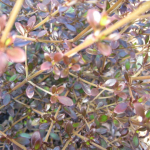
Coprosma Roys Red is a compact shrub with red-rimmed glossy leaves. Strong hardy grower withstanding a wide range of conditions including heat, drought and coastal situations. Clips well into an excellent low hedge. Also useful for topiary or as a stand alone specimen. Evergreen. Hardy.
Coprosma rubra
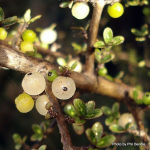
Coprosma rubra is a rare hardy shrub with stems of young branches a reddish colour. Yellow / White berries. Well-drained sites.
Small-leaved Coprosmas are good for revegetation projects, hedging, and adding texture into a garden. They are evergreen and suited to full sun to part shade. They produce berries from January to April that are dispersed by fruit-eating animals (frugivory). They also provide habitat for New Zealand’s declining lizard and gecko populations.
Mingimingi provides a tough shelter, providing good food for native birds and lizards, as well as ground cover.
Habitat: Lowland to montane. Usually in riparian forest and shrubland, especially on alluvial soils or those derived from calcareous parent materials.
Flowering: Spring - Summer [September - January]
Fruiting: Summer - Autumn [January - April]
Coprosma rugosa (Needle-leaved Mountain Coprosma)
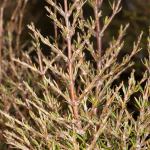
Coprosma rugosa is a hardy native shrub good for exposed sites. A divaricating shrub selected for its texture and structure. Excellent for mass planting, hedged or low maintenance, structure plantings. Evergreen. Hardy.
Habitat: Found in lowland, montane and subalpine grasslands, scrublands and forest margins.
Flowering: Spring [October - November]
Fruiting: Autumn [February - April]
Coprosma Taiko
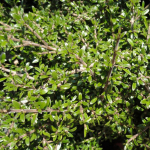
Coprosma Taiko is a vigorous prostrate dense shrub with dark green foliage turning dark purplish colour in winter. It has inconspicuous flowers which are followed in autumn by blue berries. A great groundcover or rockery plant with a springy feel and look to the intertwining branches. Works well a part of a native garden. It can tolerate windy and coastal conditions. Evergreen. Hardy.
Flowering: Summer [December - January]
Fruiting: Autumn [February - April]
Coprosma tenuifolium Purpurea
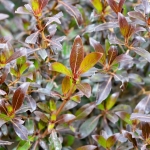 Sold Out
Sold Out
Coprosma tenuifolium Purpurea is a tough and attractive shrub can tolerate cold, snow and drought. Its' fine glossy green/purple leaves turn a deep purple as the winter approaches. Compact, upright habit makes a great addition to a mixed native planting, or a distinctive low hedge . Evergreen. Hardy.
Coprosma virescens (Mingimingi)
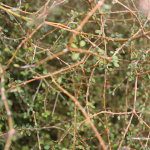
Coprosma virescens, mingimingi, is an upright shrub or small tree with attractive thin, pale-green leaves. Bark is mottled grey, pale-yellow and cream. The fruit are white or green-tinged, sometimes mottled with black. Thrives in cold conditions, partially deciduous putting the bold branch colour on show in winter.
Small-leaved coprosmas are good for revegetation projects, hedging, and adding texture to a garden. Mingimingi are evergreen and suited to full sun to part shade. They produce berries from January to April that are dispersed by fruit-eating animals (frugivory). They also provide habitat for New Zealand’s declining lizard and gecko populations. As attractors of these small animals, they are a pioneer shrub in revegetation projects. Mingimingi provides a tough shelter, providing good food for native birds and lizards, as well as ground cover for these.
Habitat: Lowland to lower montane. On well drained to poorly draining fertile soils (often overlying calcareous or base-rich igneous rocks). In forest and shrubland.
Flowering: Spring [September - November]
Fruiting: Summer [May - July]
My Lists: Pioneer Species
Coprosma Walter Brockie (Mirror Bush)
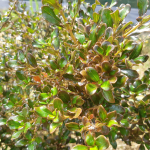
Evergreen compact shrub that withstands coastal conditions. Hardy to approximately minus 5 degrees C. Foliage glossy bronzy-brown with green young growth in spring, deeper brown in winter. Grows to about 1 metre x 1 metre, but amenable to pruning to keep shape. Will grow in sun or shade.
Cordyline australis (Ti Kouka, Cabbage Tree)
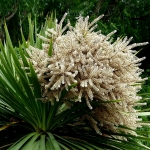
Cordyline australis, Ti Kouka, commonly called Cabbage Tree, is one of the most identifiable New Zealand native plants in the landscape. It has a tall straight trunk or trunks and a dense round head, with a sphere of long narrow leaves. Cabbage tree produces a profusion of attractive and scented flowers in spring. It is an abundant seeder. It looks most natural in the ornamental garden if planted in groups. Three or more plants can be planted together in the same hole to produce this effect. It grows in all soils and situations, even in swampy ground, where little else of interest will grow.
Cordyline australis is a light-demanding pioneer species, and seedlings die when overtopped by other trees. To grow well, young plants require open space so they are not shaded out by other vegetation. Its fruit and nectar are a favourite food source for kererū and tūī. Bellbirds like to nest in Tī Kōuka. Some lizards forage among the flowers of Cordyline australis and the nectar of the flowers is sought after by insects.
History of use: The Maoris obtained a most nutritious food, kauru, from the root of the young cabbage tree. This root is an extension of the trunk below the surface of the ground and is shaped like an enormous carrot some 2–3 ft long. An observer of the early 1840s, Edward Shortland, noted that the Maoris “prefer those grown in deep rich soil; they have learned to dig it at the season when it contains the greatest quantity of saccharine matter; that is, just before the flowering of the plant. They then bake, or rather steam it in their ovens. On cooling, the sugar is partially crystallised, and is found mixed with other matter between the fibres of the root, which are easily separated by tearing them asunder, and are then dipped in water and chewed”. The trunk of the cabbage tree is so fire-resistant that early European settlers used it to make chimneys for their huts. They also brewed beer from the root.
Medical Uses: An infusion of the leaves was used for dysentery and diarrhoea and for cuts. (From "Maori medical lore" by W. H. Goldie. 1905) The leaves were softened by rubbing and scraping. These scrapings were applied as an ointment to cuts, cracks in the skin and sores (from unpublished notes by Beryl Moore 1940). The younger inner shoots and the top of the stem were boiled and eaten by nursing mothers and were given to their children for colic. (From unpublished notes by T. Kururangi 1941)
Habitat: Widespread and common from coastal to montane forest. Most commonly encountered on alluvial terraces within riparian forest.
Flowering: Spring [October - December]
Fruiting: Summer - Autumn [January - April]
My Lists: Erosion Control, Wetland, Pioneer Species
Corokia Bronze King
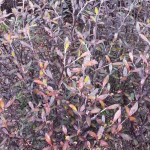
Corokia Bronze King is a handsome native shrub featuring bronze-dark green foliage that deepens in colour through winter. Small and yellow, mildly fragrant flowers are borne in spring and are followed by masses of small, red berries in autumn which attract birds. Bronze King is commonly trimmed into a hedge but is also great for including in mixed plantings, providing a colour contrast, or for growing in challenging areas.
Best results with this shrub are achieved when it is planted in full sun or partial shade on a well-drained site. It tolerates wind, frost, cool climates, coastal conditions, and dry periods once established.
Flowering: Spring [September - November]
Fruiting: Autumn [March - May]
Corokia buddleioides
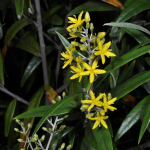
Corokia buddleioides has pale green/bronze glossy leaves. Yellow flowers (spring). Red berries (autumn). Ideal hedging. Distributed in the North Island. Northland south to outliers in New Plymouth and the volcanic plateau, not seen east of Bay of Plenty.
Habitat: Coastal to lowland forest and forest margins.
Flowering: Spring [September - December]
Fruiting: Summer - Autumn [January - May]
Corokia cotoneaster (Korokio)
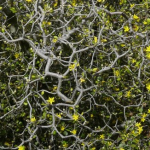
Corokia cotoneaster, or Korokio, is a good hedging and ornamental shrub. Corokia cotoneaster prefers to survive in areas that are not wet. It will grow and develop in dry, rocky, and dense soils. Attractive fine silver/grey foliage with bright yellow flowers in early summer. Densely interlaced branchlets. Red berries/seed. Evergreen. Very hardy to drought and cold.
As it is a tough plant that attracts birds and lizards, it is suitable for restoration projects. As part of the dry woodland community, it plays an important role in conditioning the soil. The soil conditioning creates a more hospitable environment for less robust species and broadleaf/podocarp forest succession. Other plants in this community include but are not limited to Discaria toumatou, Poa cita, Ozothamnus leptophyllus, Sophora prostrata, Melicytus alpinus and Cordyline australis.
Habitat: Found in scrub and on dry river flats and rocky places throughout the country.
Flowering: Spring [September - December]
Fruiting: Summer - Autumn [January - May]
Corokia Emerald and Jade
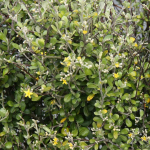
Corokia Emerald and Jade is an evergreen native shrub, noted for its vibrant-green foliage and compact growth habit. The leaves are a striking emerald green, providing year-round colour and interest. This plant grows to approximately 1.5m in height and width, making it perfect for use in hedges or as a standalone feature in garden beds or containers. It prefers well-drained soil and can tolerate full sun to part shade. As a bonus, Emerald and Jade produces small yellow flowers in the spring, followed by attractive red berries in the autumn, adding to its overall appeal.
Flowering: Spring [September - November]
Fruiting: Autumn [March - May]
Corokia Frosted Chocolate
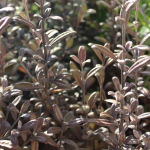
Corokia Frosted Chocolate has a dense hardy chocolate bronze foliage that intensifies in the colder months. This native offers a neutral and maintenance free back drop to many planting plans. Excellent as hedge or single plant in coastal, dry or frosty areas. Yellow starry flowers (summer). Red berries (autumn). Slender and compact.
Flowering: Spring [September - December]
Fruiting: Summer Autumn [January - May]
Corokia Geentys Green
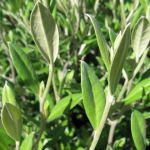 Sold Out
Sold Out
Corokia Geentys Green is a native evergreen, is fast becoming fashionable for its hedging and bordering appearance. With its dense, hardy, pale green foliage, it offers a neutral and maintenance free back drop to many planting plans. Excellent as hedge or single plant in coastal, dry or frosty areas. Yellow starry flowers followed by red berries. Slender and compact. Evergreen. Hardy.
Flowering: Spring [September - December]
Fruiting: Summer - Autumn [January - May]
Corokia Sunsplash
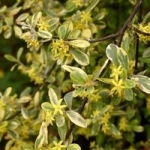
Corokia Sunsplash is a yellow form of the popular Corokia. Brilliant splash of colour for any native garden, very hardy and effective landscaping shrub. Small starry, yellow flowers are mildly fragrant and are followed by small red berries. Evergreen. Hardy.
Flowering: Spring [September - December]
Fruiting: Summer - Autumn [January - May]
Corokia Yellow Wonder
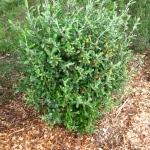
Corokia Yellow Wonder is an upright shrub densely branched. Green foliage. Starry yellow flower followed by masses of golden-yellow berries. This native offers a neutral and maintenance free back drop to many planting plans. Excellent as hedge or single plant in coastal, dry or frosty areas. Evergreen. Hardy.
Flowering: Spring [September - December]
Fruiting: Summer - Autumn [January - May]
Cupressus Ovensii (Ovens Cypress)
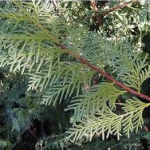
Cupressus Ovensii is a narrowly conical, evergreen conifer. Attractive, dark green, flattened foliage makes a great, dense hedge with trimming. Rapidly growing, with straight growth and canker resistance. Ideal for forestry, or trimmed shelter belt. Good timber, forms heart wood early. Grows approximately 7m tall after 5 years, and 30m when mature. Can be kept trimmed as low as 3m with annual pruning.
Full sun to part shade. Suits all soil types. Tolerant of strong winds but only some coastal exposure. Frost hardy.
Cyperus ustulatus (Upoko-Tangata, Giant Umbrella Sedge)
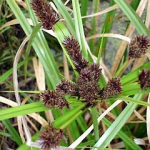 Sold Out
Sold Out
Cyperus ustulatus, giant umbrella sedge, is a fast growing sharp-edged swamp grass with olive green leaves. Ideal for wetland re-vegetation. Quick to colonize damp areas which will eventually establish tall swamp forests. The arching dark green foliage is complemented with green flowers in summer which age to a showy brown.
History of use: Colenso 1869 reported that the Maoris stripped off outside edges of the leaves and use them for mats, baskets and for kite making. An upoko-tangata kite was featured on a set of matariki (Maori New Year) stamps issued by New Zealand Post in 2010. They also use the leaves as an outer thatch on their whares (dwellings). Medically the pith was boiled with water, strained and used in the North Auckland districts for kidney trouble (Adams 1945).
Habitat: Coastal to lowland sites in open ground. Tolerant of a wide range of habitats and conditions but evidently preferring wetland margins, seepages, streamsides, lagoon and estuary margins.
Flowering: Spring - Summer [July - December]
Fruiting: Summer - Autumn [July - April]
My Lists: DrainField, Wetland
Dacrycarpus dacrydioides (Kahikatea, White Pine)
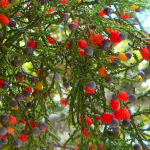
Dacrycarpus dacrydioides, commonly called kahikatea or white pine, is the tallest growing native tree, featuring handsome mature foliage and attractive buttressed roots. Best planted in moist to wet situations. The main tree species in Riccarton Bush. Edible fruit/seed from February to April is attractive to birds. On swampy sites Dacrycarpus dacrydioides develops buttresses for stability which extend to the roots. Not a garden tree. Ideal for revegetation planting, particularly in wetter areas and riparian projects. This native is frost-tolerant. Slow growing, loves fertile, swampy ground but can handle drier sites with good rainfall. Evergreen. Intolerant of heavy frosts.
Habitat: Lowland forest, formerly dominant on frequently flooded, and/or poorly drained alluvial soils. Occasionally extends into lower montane forest. Once the dominant tree of a distinct swamp forest type all but extinct in the North Island - the best examples remain on the West Coast of the South Island.
Flowering: Spring - Summer [October - January]
Fruiting: Autumn [February - April]
My Lists: Wetland
Dianella nigra (Turutu, NZ Blueberry)
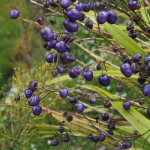 Sold Out
Sold Out
Dianella nigra, Turutu, has bright iridescent blue berries in summer, this small evergreen flax like plant works well in most situations and is especially attractive planted naturally in groups. Ideal for dry areas under existing vegetation. Turutu grows up to 50 cm tall and about 50 cm wide, making it a perfect smaller substitute for flaxes and does much better in semi shade than the unrelated mountain flax. The magnificent bright blue and fleshy berries that arise during summer from tiny white flowers with yellow stamens. The berries are spread and eaten by native birds.
Habitat: Coastal to montane (rarely subalpine) . Colonising a wide variety of habitats from open coastal headlands, gumland scrub and less frequently peat bogs through to dense forest and subalpine scrub.
Flowering: Spring [November - December]
Fruiting: Summer - Autumn [November - May]
Dianella revoluta
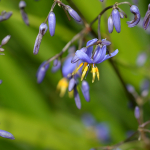
Dianella revoluta is a desirable plant because once it is established it is very hardy and has a wide moisture and temperature range excluding inland extremes. It is drought and frost resistant, is generally trouble-free and is grown for its distinctive strappy foliage as well as for its flowers and fruits. D. revoluta provides long periods of interest in gardens looking decorative with its compact, clumping and evergreen foliage. It is suitable for most soils, but prefers a well drained soil enriched with leaf mould and compost, and accepts part or full shade. It looks best in mass planting and makes a lovely understorey plant while adding texture. It is suitable for most rockeries and can be grown as a border or just adding quality to the bushland garden.
Flowering: Spring [November - December]
Fruiting: Summer - Autumn [December - May]
Dianella variegata
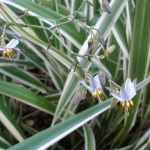 Sold Out
Sold Out
Dianella variegata is a clumping dianella grown for its bold white striped leaves. The small flowers which appear in mid spring have pale violet sepals with white-striped green petals. These flowers are followed by attractive dark blue berries. It is best grown in light shade but will do well in full sun if grown in well drained soil.
Flowering: Spring [November - December]
Fruiting: Summer [December - February]
Dichondra repens (Kidney Weed)
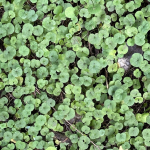 Sold Out
Sold Out
Dichondra repens (Kidney Weed) is a perennial ground cover forming a lush carpet of small, bright green, kidney-shaped leaves. Its creeping stems root wherever the nodes touch the ground. Inconspicuous flowers produce seeds that may remain in the soil for many years before sprouting.
Ground-hugging, Dichondra repens is maintenance free, and useful for spots where normal grasses may not do as well. Handsome between pavers, it can tolerate light foot traffic. A great lawn alternative, its chief advantage over grass is that it doesn't need mowing. It can also be used in rockeries.
Flowering: Spring - Summer [September - February]
Fruiting: Summer - Autumn [November - May]
Discaria toumatou (Matagouri)
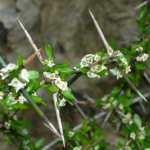
Discaria toumatou, commonly called Matagouri, is a tangle-branched, extremely thorny, divaricating shrub or small tree up to five metres tall. It has small leathery leaves close to the thorns, which are only abundant in spring or the shade. The flowers are tiny and white with no petals. It is the only New Zealand native plant that has thorns. Nitrogen-fixer. Common in dry shrublands of the eastern South Island.
It is most common in tussock grassland, stony areas and river beds. It is common in the eastern South Island, and found in a few coastal localities in the North Island south from the mouth of the Waikato River. As with other Discaria species it fixes nitrogen from the atmosphere with the help of symbiotic bacteria of the genus Frankia in its roots. It often grows in association with mingimingi (Coprosma propinqua), porcupine shrub (Melicytus alpinus, an alpine mahoe) and native brooms (Carmichaelia species). Seeds are dispersed by ballistic projection and water.
Matagouri plays an important ecological role in providing habitat and food sources for various native bird species, including silvereyes and bellbirds. The dense, spiny branches offer protection from predators and nesting sites for birds. Matagouri also helps stabilise the soil and prevent erosion in exposed and fragile environments.
As a native plant matagouri has complete protection on public conservation land and a degree of protection on private land under the Resource Management Act 1991. In a notable case a 400 ha area of matagouri forest, including trees that may have been 150 years old, was illegally sprayed at the head of Lake Sumner in 2001.
Habitat: Found in dry riverbeds, open rocky places and sand dunes from coastal to subalpine.
Flowering: Spring - Summer [October - January]
Fruiting: Summer [December - March]
Disphyma australe (Horokaka, Coastal Ice Plant)
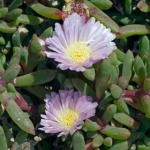
Disphyma australe, Horokaka, commonly known as the NZ Native Ice Plant, this is a fast-growing groundcover that is found naturally along coast lines. Plants carry thick and succulent leaves which enable it to survive extended periods of dry. It features pale pink and white daisy-like flowers in summer that open and close with the sun. This succulent typically grows to 20 cm tall and 50 cm wide, preferring a full sun position with good drainage. This plant is commonly used as a groundcover where it can grow over rocks or planted to spill over the edge of retaining walls. It also makes for a fantastic indoor plant and is well suited to planting around outdoor living areas. It is often included in coastal plantings to help retain sand. Plants can be frost sensitive when young.
History of use: Early Europeans pickled the leaves and the ripe fruit was eaten raw. Maoris treated boils with juices from the leaves.
Habitat: It is a coastal plant and is rarely found inland. Mostly found on cliff faces, rock stacks, and boulder/cobble beaches, more rarely in saltmarsh and estuaries. Often in petrel scrub on offshore islands, and extending into coastal forest around petrel burrows. Often where seabirds nest it is the only plant growing.
Flowering: [Throughout the year]
Fruiting: [Throughout the year]
Dodonaea viscosa (Ake Ake)
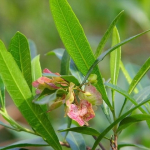
Dodonaea viscosa, commonly called Akeake, is an ornamental small bushy erect tree. Attractive brown flaky bark. The long shining leaves are bright green and dense on erect branches. The seed capsule is most attractive in the autumn. Wind resistant, and grows in coastal sites. Good for shelter in light sandy soils.
Habitat: Coastal to lowland forest, occupying a range of habitats from dunefields and boulder beaches through coastal scrub to lowland forest. Rarely forming a dominant tree in coastal forest.
Flowering: Spring - Summer [September - January]
Fruiting: Summer - Autumn [November - April]
Dodonaea viscosa Purpurea (Ake Ake Purpurea)
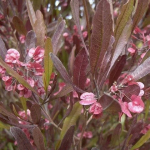
Dodonaea viscosa Purpurea, commonly called Ake Ake, is an ornamental small bushy erect tree. Attractive brown flaky bark. The long shining leaves are purple-red, intensifying in colour in winter. The seed capsule is most attractive in the autumn. Wind resistant, and grows in coastal sites. Good for shelter in light sandy soils. Very hardy for establishing in difficult soil.
Flowering: Spring - Summer [September - January]
Fruiting: Summer - Autumn [November - April]
Echeveria elegans (Mexican Snowball)
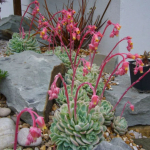 Sold Out
Sold Out
Echeveria elegans is also known as Mexican Snowball is a dense, blue-gray succulent species from Mexico that mounds or spreads slowly in tight colonies. Edges of leaves are slightly pink, producing equally pretty small pink flowers with a yellow tinge in spring. Very handsome and uniform in the garden.
Flowering: Spring [September - November]
Fruiting:
Eleocharis acuta (Common Spike Rush)
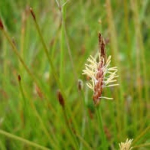 Sold Out
Sold Out
Eleocharis acuta, commonly called Common Spike Rush, is a wetland plant which forms dense strands of upright, mid to dark-green cylindrical stems. Small cream to brown spikes appear at the tip of the foliage from spring to autumn. Great for stabilising banks, or an ornamental for ponds in shallow water. Attractive to both birds and insects.
Plant communities that include Apodasmia similis, Carex maorica, Carex secta, Carex virgata, and Phormium tenax often contain Eleocharis acuta.
Habitat: Coastal to montane. Common in open to partially shaded permanently damp ground. Usually in swamps, and on stream, river, pond, and lake margins. Sometimes present in seepages within pasture.
Flowering: Spring - Summer [September - January]
Fruiting: Summer - Autumn [October - May]
My Lists: Wetland
Erica x darleyensis Pink (Winter Heath Pink Flower)
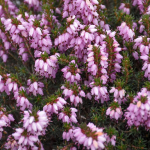
Erica x darleyensis pink, or Winter Heath, is a popular plant that establishes quickly for a dense ground cover or border. Mounding evergreen shrub with terrific winter colour, its pink flowers last through early spring.
Performs best in full sun in sandy, acidic, medium moisture, well-drained soils. Part shade is welcomed in hot summer areas. Newly planted Heath can dry out quickly once planted, so it is important to water regularly and thoroughly when the plant is young.
Easy to grow, this plant is a welcomed addition to rock gardens, groundcover, slopes, coastal gardens, cottage gardens, or container. Plant in groups for the best visual impact.
Flowering: Winter - Spring [June - October]
Fruiting:
Erica x darleyensis White (Winter Heath White Flower)
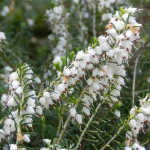
Erica x darleyensis white, or Winter Heath, is a popular plant that establishes quickly for a dense ground cover or border. Mounding evergreen shrub with terrific winter colour, its white flowers last through early spring.
Performs best in full sun in sandy, acidic, medium moisture, well-drained soils. Part shade is welcomed in hot summer areas. Newly planted Heath can dry out quickly once planted, so it is important to water regularly and thoroughly when the plant is young.
Easy to grow, this plant is a welcomed addition to rock gardens, groundcover, slopes, coastal gardens, cottage gardens, or container. Plant in groups for the best visual impact.
Flowering: Winter - Spring [June - October]
Fruiting:
Escallonia Apple Blossom
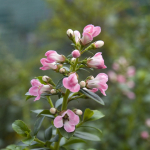
Escallonia Apple Blossom has masses of apple-blossom pink, tubular flowers among small, glossy, dark green leaves. This compact, bushy, evergreen shrub looks lovely towards the back of a sunny shrub border, or as a foil for flowering perennials, or for growing as an informal flowering hedge. It is particularly effective as a windbreak.
It is an easily grown shrub with a bushy habit and typically grows to 1.5 m tall and the same wide and can be trimmed as necessary. Best performance with this evergreen is achieved when it is grown in full sun on a well-drained site though it is hardy to moderate frost and dry periods.
Flowering: Spring - Summer [October - January]
Fruiting:
Escallonia Field Scarlet
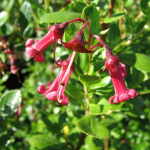
Escallonia Field Scarlet is a popular hybrid with scarlet flowers and medium sized leaves. Escallonia Fields Scarlet is a fast growing evergreen shrub flowering with pink flowers most of the time from early spring to late autumn. It will give year round structure and appeal to your border. Thrives well in exposed windy sites and is very hardy. Suitable for a mixed border or can be clipped as a formal hedge. Evergreen. Hardy.
Flowering: Spring - Summer [October - January]
Fruiting:
Escallonia Red Knight
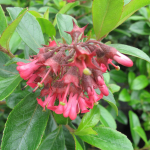
Escallonia Red Knight is a compact medium shrub with glossy green leaves producing clusters of deep cerise flowers from Spring to Autumn. Used as a border or hedging plant.
Flowering: Spring - Summer [October - January]
Fruiting:
Escallonia White Profusion
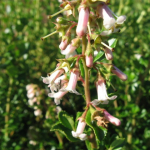
Escallonia White Profusion foliage is dark green, glossy, and leathery, with a serrated edge. The leaves are arranged in an opposite manner along the stems, creating a dense and compact shrub that can reach a height of 2.5 meters, making it an ideal choice for hedges or screens.
The flowers of Escallonia White Profusion are the main highlight of this cultivar. They are abundant, small, and tubular, with a pure white color that contrasts beautifully against the dark green foliage. The flowers are borne in clusters at the ends of the branches, creating a profusion of blooms during the flowering season, which typically occurs in summer or early fall, depending on the climate.
In addition to its aesthetic appeal, Escallonia White Profusion is also known for its ability to attract pollinators such as bees and butterflies, making it a beneficial addition to pollinator-friendly gardens. It is also considered to be relatively drought-tolerant once established, although it prefers well-drained soils and regular watering.
Plant in a sunny or part - sun situation with good drainage. Can tolerate high winds and dry soil but this will slow growth. Hardy down to minus 10.
Flowering: Spring - Summer [October - January]
Fruiting:
Euonymus fortunei Emerald Gaiety (Fortune)
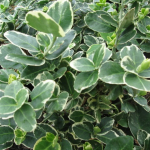
Euonymus fortunei Emerald Gaiety is a low growing, variegated bushy shrub that makes for an excellent groundcover or border. Is a mainstay of low-maintenance gardens, but it also makes a good foil for more ornamental flowering shrubs. It is tough and will thrive in any well-drained border in sun or partial shade.
Grow Euonymus fortunei Emerald Gaiety in moist but well-drained border in sun or partial shade. Cut back growth by one-third in the first spring after planting to encourage a bushy habit, and remove any plain green reverted stems whenever seen.
Euonymus fortunei Emerald Gem (Winter Creeper Euonymus)
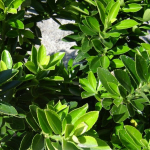
Euonymus Emerald Gem is a densely growing foliage shrub with glossy green leaves, neat and compact for all seasons. Easy to grow and hardy. Suitable for tubs, dwarf hedging, clipped for topiary or rockeries. Emerald Gem grows best when positioned in full sun or partial shade on a well-drained site, though it will tolerate dry periods, moderate frost, coastal conditions, and cool climates. A great alternative to buxus as a small hedge.
Flowering: Summer [December - January]
Fruiting:
Euonymus fortunei Emerald n Gold (Fortune)
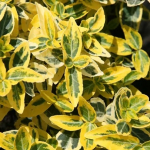
Euonymus fortunei Emerald n Gold is one of the most versatile evergreen shrubs with a spreading habit it has broad yellow-margined leaves with fine autumn and winter colour which are tinged pink in winter. It makes an excellent specimen shrub.
A compact, evergreen hedging or ground cover plant, Euonymus fortunei Emerald n Gold is a great addition when looking for an attractive, low growing shrub. Brightly coloured yellow and green foliage, turning pink in winter for added warmth and a bushy habit makes it ideal for garden borders and pathways.
Fatsia japonica (Japanese aralia)
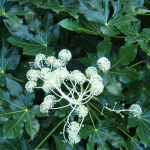
Fatsia japonica has dark green, glossy leaves that are held on spreading stems. The leaves are very large and have a maple-leaf shape, giving this plant a tropical look - it’s native to southern Japan, southern Korea, and Taiwan and in fact, the word "fatsi" is an approximation of the old Japanese word for 'eight', referring to the eight lobes of the leaves. The flowers appear on candelabra-like clusters of small, rounded flower heads in autumn. This shrub is ideal in a shady spot or in a large pot, it can even grow in a cool room indoors.
Flowering: Autumn [March - May]
Fruiting: Winter [June - July]
Festuca actae (Banks Peninsula Blue Tussock)
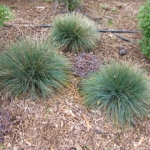
Festuca actae, commonly called Banks Peninsula Blue Tussock, is a small tussock with fine rolled blue foliage from Banks Peninsula. The erect flowering stems reach 75cm. Tolerates full sun but grows best in light shade in southern climates. The showy yellow flowers in late spring bring interest to the garden and can provide food for birds in autumn.
Habitat: Coastal to montane. On rocks, rock outcrops, bluffs, talus and stabilised, sparsely vegetated slopes.
Flowering: Spring [October - December]
Fruiting: Summer - Autumn [November - April]
Festuca novae zelandiae (Hard Tussock)
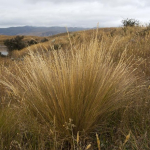
Festuca novae-zelandiae is a fine-leaved tawny tussock, upright in habit. A common component of low tussock grasslands on dry, windy and cold plains in Canterbury & Otago. It is deep rooted and dominant on steep, exposed slopes. In alpine areas at lower altitudes Festuca novae-zelandiae is associated with the narrow-leaved snow tussock (Chionochloa rigida). Stunning grass en masse. Needle thin erect leaves green to blonde. Tolerates poor soil and dry conditions.
The tawny leaves are 15-60cm long and have a width of 0.5-1mm. They are rough to touch and have sharply pointed tips. The margins are tightly in rolled giving the leaf a cylindrical appearance. The flowering stems are up to 70 cm tall with a 5-12 cm long open flowering panicle.
Habitat: Short tussock grasslands. Pre-1900s short tussock grassland covered considerable areas of the eastern South Island from sea level up to between 800 and 900 metres high.
Flowering: Spring [September - November]
Fruiting: Summer [December - February]
Ficus pumila (Climbing Fig)
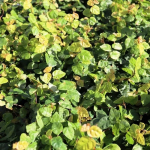
Ficus pumila, Climbing fig, is a fantastic perennial climbing hedge plant, as it looks like a hedge when growing up walls. Its young leaves are heart-shaped and grow quickly, making it an ideal plant to use to cover up any unsightly walls or large open garden spaces. It is shade tolerant and extremely hard-wearing once established. Plant 1m apart to cover a wall.
Fuchsia excorticata (Kotukutuku, Tree Fuchsia)
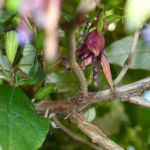 Sold Out
Sold Out
Fuchsia excorticata, also known as Kotukutuku, Tree Fuchsia, and New Zealand Fuchsia. Native to New Zealand and considered to be the worlds largest fuchsia. Attractive, small flowers begin to appear in mid spring. They are greenish-yellow then turn purple-red. followed by dark purple berries that are edible and tasting similar to tamarillo. It is easily recognised in its native environment by the characteristic appearance of its bark, which peels spontaneously, hanging in red papery strips to show a pale bark underneath. Plant in full sun or partial shade, hardy, semi-deciduous to deciduous.
Kōtukutuku is also a favoured food for bees. Other native trees that provide excellent food for honey bees and our own native bees (Leioproctus, Lasioglossum, and Hylaeus genera), are Psuedopanax arboreus, Cordyline australis, Schefflera digitata, Kunzea, and Pittosporum tenuifolium.
Habitat: Found in lowland and montane forests, especially along forest margins and streamsides where the soil is damp.
Flowering: Winter - Spring - Summer [July - January]
Fruiting: Summer [November - March]
My Lists: Winter Pollen
FoodSource for: Birds(F,S,N,O), Bees, Insects, Lizards
Fuchsia procumbens (Creeping Fuchsia)
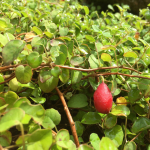
Fuchsia procumbens, or Creeping Fuchsia, is a rather exotic Fuchsia, unlike most common types, unique for its creeping habit. This species grows much like a groundcover, often not exceeding more than a few inches in height. Bears pretty rainbow flowers followed by firm-fleshed, edible berries.
It is now a rare species in the wild because of the destruction of its natural habitat and is listed as an endangered plant species.
Habitat: Fuchsia procumbens is a prostrate shrub that is endemic to coastal areas of the North Island of New Zealand. A strictly coastal species. F. procumbens has been collected from cobble/gravel beaches, coastal cliff faces, coastal scrub and grassland, dune slacks and swales, and from the margins of saltmarshes (in places where it would be inundated during spring tides).
Flowering: Spring - Summer [September - May]
Fruiting: Summer - Autumn [November - July]
My Lists: Rare Plants
Fuscospora cliffortioides (Tewhai Rauriki, Mountain Beech)
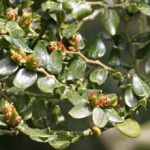
Fuscospora solandri var. cliffortioides is known as Mountain Beech because it is found at higher altitudes than Black Beech and can be found at various altitudes. It does not grow as tall as F. solandri and tolerates hard, dry infertile , poorly-drained sites in alpine areas. Differs from black beech by the finer leathery leaves with acute apices and obscure leaf venation. Although the two are closely allied and readily form hybrids, they are distinct species.
Habitat: Found in montane and subalpine forest and subalpine scrub. Often forming a dense, almost monospecific forest especially along the drier eastern side of the South Island.
Flowering: Summer [November - January]
Fruiting: Autumn [February - April]
Fuscospora fusca (Tawhai Raunui, Red Beech)
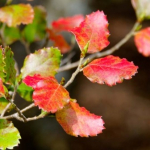
Fuscospora fusca, commonly called Red Beech, as a young tree has bright-red foliage during winter. Rapid early growth. Strong durable red wood. Can clip to a formal hedge. Suits a cool, moist, sheltered site with deep, well-drained soil. Evergreen.
Habitat: Found in lowland and montane forests.
Flowering: Spring [September - December]
Fruiting: Summer [November - March]
Fuscospora solandri (Tawhai Rauriki, Black Beech)
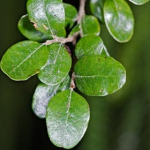
Fuscospora solandri, commonly called Black Beech, is a tall attractive tree with black bark and tough leathery leaves. Wind-hardier than other beeches. Suits moderately fertile, well-drained soils at low altitude in drier eastern areas. Evergreen.
At times Beech dominate the canopy, forming its own distinctive forest type. Often found in hardwood forest plant communities that include but are not limited to Aristotelia serrata, Pittosporum eugenioides, Pseudopanax arboreus, Podocarpus totara and Fuscospora cliffortioides among others. Differs from mountain beech by the oblong leaves with obtuse apices and obvious leaf venation. Although the two are closely allied and readily form hybrids, they are distinct species.
Known as black beech because it is prone to a sooty mould that covers the trunk and branches as a result of scale insect infestation. The insect secretes honeydew, feeding the mould and attracting birds and bees.
Habitat: Lowland to montane forest. At times the canopy dominant and forming its own distinctive forest type.
Flowering: Spring [September - December]
Fruiting: Summer [November - April]
Griselinia Broadway Mint (Broadleaf)
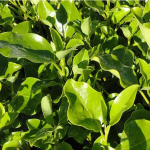
Griselinia Broadway Mint, a broadleaf native hybrid, is a must for any garden that needs a screen, private area, wind protection or just an attractive evergreen plant with glossy deep green slightly wavy edged leaves. It is quick to establish itself and requires little maintenance or attention to thrive. It can be planted in sun or shade and in moist free draining soils. Evergreen. Hardy.
Flowering: Summer [November - January]
Fruiting: Autumn [February - August]
Griselinia Canterbury (Kapuka, Broadleaf)
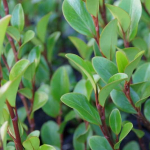
Griselinia Canterbury, commonly called Broadleaf, is a dependable, quick-growing shrub forming a dense, attractive hedge. Canterbury is known for its’ attractive dark red stems and finer rich-green foliage. Can be clipped and maintained into formal hedging to provide good colour and texture to your landscape. Tolerant of just about any planting conditions including coastal. Evergreen. Hardy.
Flowering: Summer [November - January]
Fruiting: Autumn [February - August]
Griselinia littoralis (Kapuka, Broadleaf)
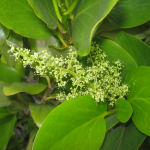
Griselinia littoralis, Kapuka or Broadleaf, is a very hardy evergreen tree. With regular trimming it makes a popular and effective hedging shrub. Grows in a range of soil types but prefers well-drained soil in full sun. Can tolerate frost and wind. It is useful in coastal situations (littoralis means shore growing) as it will tolerate frost, rough winds and salt spray. It is also a good upper bank plant for riparian plantings.
The oval leaves are leathery glossy and lush bright green. This plant produces small cream insignificant flowers that attract native pollinators. The tiny green and yellow flowers are also a good source of pollen for bees in the spring. In autumn the female trees have small purple-black fruit which tui eat.
History of use: It was an opening medicine and the inner bark was used on scrofula (a tuberculous infection of the skin on the neck). The timber was known for its durability.
Habitat: Found in lowland forests to subalpine scrub.
Flowering: Summer [November - January]
Fruiting: Autumn - Winter [February - August]
Haloragis erecta (Toatoa, Fire Weed)
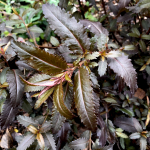
Haloragis erecta, Toatoa (not to be confused with other NZ plant species also known as toatoa) is a small perennial shrubby plant endemic to NZ, growing from sea level to about 500m altitude, distinctive for its toothed leaves and reddish stems. Toatoa readily colonises cleared or burnt ground, giving rise to another common name, fire weed.
Habitat: Coastal to montane in forest or scrub. Often on slip scars or colonising recently cleared ground. Often appearing following fire (hence one of the common names).
Flowering: [Throughout the year]
Fruiting: [Throughout the year]
My Lists: Pioneer Species
Helianthemum Pink (Pink Rock Rose)
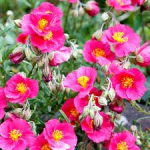
Helianthemum, commonly called Rock Rose, is a low growing shrubby perennial with woody dark green-grey foliage, pink flowers with yellow centre. Ideal for rockery in a sunny spot. Found in the North Atlantic region, mainly in dry grassy and rocky places across large parts of Europe.
Flowering: Summer [November - February]
Fruiting:
Helianthemum White (White Rock Rose)
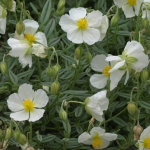
Helianthemum, commonly called Rock Rose, is a low growing shrubby perennial with woody greenish grey foliage, comes in white flowers with yellow centres. Ideal for rockery in a sunny spot. Found in the North Atlantic region, mainly in dry grassy and rocky places across large parts of Europe.
Flowering: Summer [November - February]
Fruiting:
Helictotrichon sempervirens (Blue Oat Grass)
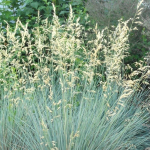
Helictotrichon sempervirens, commonly called Blue Oat Grass, is a tufted grass with erect silver-blue leaves. Produces glistening straw-coloured flowers on long stems during summer. Prefers a sunny, moist but well-drained place in the garden.
Flowering: Summer [December - February]
Fruiting: Summer [December - February]
Helleborus orientalis (Winter Rose)
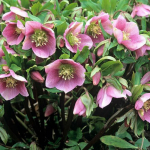
Helleborus orientalis, commonly called Winter Rose, is a winter-flowering staple in the cottage garden, hellebores produce large clusters of saucer-shaped flowers with white, pink, green, mauve or smoky purple flowers. The large leathery, evergreen leaves persist throughout the year but should be cut back in the spring when flowers and new foliage emerge.
Happiest in semi-shade and humus rich well drained soil. Eventually forms a large clump and will really stand out in the winter garden.
Flowering: Winter [June - August]
Fruiting:
Heuchera (Coral Bells)
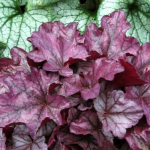
Heuchera, commonly called Coral Bells, are at home in woodlands, rock gardens, containers, borders and as ground covers. Heuchera make wonderful edging plants and really put on a show when planted in groups. The foliage color is great for playing up the colors of nearby flowers. Darker purple leaves can make yellow flowers glow.
Flowering: Summer [November - January]
Fruiting:
Hoheria angustifolia (Houhere, Narrow-leaved Lacebark)
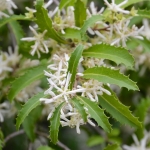
Hoheria angustifolia, Houhere, commonly known as Narrow-leaved Lacebark, is a tree native to New Zealand. It is a member of the family Malvaceae and is known for its striking appearance, with its slender leaves and attractive flowers. The leaves of Hoheria angustifolia are narrow and lanceolate.
The flowers of Hoheria angustifolia are one of its most distinctive features. They are typically large and showy, measuring 1.5-2 cm in diameter and arranged in clusters at the tips of the branches. The flowers are usually white and fragrant, and attract pollinators such as bees and butterflies.
The bark of Hoheria angustifolia is smooth and greyish-brown when young, becoming rougher and more fissured with age. The bark peels off in strips, revealing a lighter colored inner bark, which adds to its aesthetic appeal.
Hoheria angustifolia is primarily grown as an ornamental tree in gardens and parks, appreciated for its graceful form, attractive flowers, and interesting bark. It is also used in ecological restoration projects for its ability to attract pollinators and provide habitat for birds and insects.
History of use: The inner bark of Hoheria angustifolia has been used traditionally by Maori for making rope and twine.
Habitat: A common mostly lowland forest species frequenting alluvial forest where it may at times be dominant. Hoheria angustifolia is often an important host for taapia (Tupeia antarctica).
Flowering: Summer [December - March]
Fruiting: Autumn [February - April]
Hypericum Hidcote (St Johns Wort)
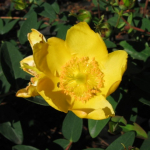
Hypericum Hidcote, or St John Wort, is an evergreen shrub producing masses of bright yellow flowers in summer, followed by large dark berries. Trim in spring and deadhead to increase flowering. One of the few shrubs that will survive in pure clay.
Flowering: Summer - Autumn [December - April]
Fruiting:
Iberis sempervirens (Candytuft)
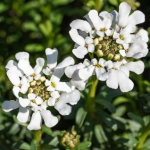
Iberis sempervirens, commonly called Candytuft, is an evergreen perennial that slowly spreads to form a tidy cushion of shiny dark green leaves. In late spring and early summer, numerous snow-white flowers nearly cover the foliage. Iberis sempervirens makes an effective edging for a sunny border.
A fabulous little plant that you should not be overlooked. Iberis sempervirens is an enchanting low, sprawling, woody-based perennial that will charm your garden in mid to late spring. Among the purest garden white flowers, the blossoms stand out starkly against the foliage of narrow, dark green leaves.
Prefers full sun locations and enjoys average, well-drained soils. Part shade is tolerated but will flower less. Good drainage is essential. This plant is drought tolerant once established. Tolerates poor soils but intolerant of wet and poorly-drained soils
Evergreen Candytuft is a remarkable edging plant for borders, paths, or walkways. It is also particularly attractive in rock gardens or cascading over the edge of raised beds and can be used as a ground cover in small areas. A great addition to cottage gardens, coastal gardens, or containers. Cut back by 1/3 after flowering to promote new growth and maintain a dense habit.
Flowering: Spring - Summer [October - February]
Fruiting:
Juncus edgariae (Wiwi, Edgars Rush)
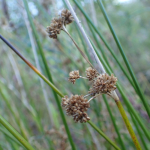
Juncus edgariae, or Wiwi, is a common rush of swampy areas throughout New Zealand. Grows in tight clumps with bright-green stems. Useful for wet areas and revegetation of wetlands, but will tolerate dry conditions for short periods. Evergreen. Hardy.
Often found in plant communities that include but are not limited to Apodasmia similis, Carex maorica
Carex secta, Carex virgata, Phormium tenax, and Eleocharis acuta.
Habitat: Easily the most common indigenous species. Coastal to alpine (1600 m a.s.l.) but mainly coastal to montane. Usually in open shrubland, fringing wetlands, and in seasonally damp sites. Often found invading pasture and in urban areas.
Flowering: Spring - Summer [October - December]
Fruiting: Summer - Autumn [November - April]
My Lists: Wetland, Pioneer Species
Kunzea ericoides (Kanuka)
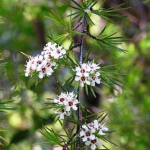
Kunzea ericoides, Kanuka tree, is a fast growing tree found throughout the north of the South Island. The leaves are softer to touch than Manuka and has smaller white flowers in Summer. It is very hardy, tolerating drought, frosts and poor soils. It is a primary colonising plant and used for revegetation as a nurse plant. Both manuka and kanuka are used as a nurse crop with other early colonizing plants for revegetation / restoration planting and are also very effective in erosion control. It is fast-growing, but short-lived, living up to 150 years. A juvenile takes about seven years to reach reproductive maturity. Very hardy.
History of use: The name "tea-tree" comes from the early bushman who used Manuka and Kanuka leaves to brew a drink similar to tea. Captain Cook was the first person to brew tea from manuka and said that it had a very agreeable, bitter taste when made with fresh leaves, but lost some of it piquancy when made with dry leaves. Kanuka leaves produce a tea that isn't quite as flavourful. Both tea-trees supposedly have medicinal uses and properties whose benefits far outweigh any considerations of taste. The leaves, brewed in water, help urinary complaints and reduced fevers.
The Maori and early settlers used to chew young shoots or swallow a drink made from seed capsules as a cure for dysentery and diarrhoea. The liquid from boiling the bark was used to treat constipation, as a sedative to promote sleep and reduce fever, for bathing sore eyes, treating colic, inflamed breasts, scalds and burns. The white gum was applied to scalds and burns and was taken by adults and children to relieve coughing. There are much more medicinal uses to which tea-tree was put to. Kanuka flowers produce a reasonable amount of nectar that is quite favoured by honeybees. The thick golden honey is hard to remove from honeycombs, but is quite popular for its strong taste and reputed antibacterial properties. Nowadays New Zealand’s monofloral Manuka and Kanuka pharmaceutical honey are both renowned for their natural health benefits.
The tough wood was used by Maori for implements such as fern root beater, mauls, paddles, weapons, spade blades, weeders, digging sticks and bird spears. The timber was noted for its straight grain, durability and strength by early European settlers, and was in demand for wheel-spokes, tool handles and other such purposes. Kanuka and Manuka wood is commonly used as firewood, especially for barbeques, or charred into charcoal. Older trees of have their trunks covered with a light brown bark that readily strips off, and is frequently used for fire-kindling. Both Manuka and Kanuka branches have been used to make brush brooms.
Habitat: Coastal to lowland shrubland, regenerating forest and forest margins, also present in montane forest, ultramafic shrubland and very occasionally present in subalpine shrubland.
Flowering: Spring - Summer [September - February]
Fruiting: Autumn [March - April]
My Lists: Erosion Control, Pioneer Species
(Taxonomists recently confirmed that K ericoides, K robusta, and K serotina are all the same species and declared all South Island Kānuka Kunzea ericoides.)
Lavandula angustifolia (English Lavender)
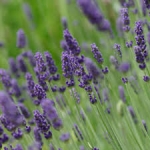 Sold Out
Sold Out
Lavandula angustifolia, commonly called English Lavender, is a sun loving perennial herb plant with mid to late spring bloom time. It is known as a xerophyte which by definition is a plant that has adapted to living in dry climate conditions. Poor soils are not a problem and are in fact preferred over rich moist ones. This makes Lavender perfect for sun drenched planting locations such as a hot dry bank that can be a real landscape problem area and can still withstand cold conditions during fall and winter. Evergreen. Hardy.
Excellent for crafts and dried flowers as they retain their color.
English Lavender (Lavandula angustifolia), also called True Lavender or Common Lavender is a type of lavender often associated with the famous purple lavender fields of Provence. Despite its common name, it is not native to England, but to the Mediterranean and counts over 40 different cultivars with flower spikes varying from blue-purple, lavender, violet-blue to white-pink.
Flowering: Spring - Summer [November - March]
Fruiting:
Lavandula dentata (French Lavender)
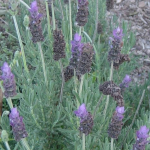
Lavandula dentata, also known as French Lavender, is most often grown in pots or tubs, to be wintered indoors in all but very mild winter regions. Plants form a bushy shrub of grey-green, finely-toothed fragrant leaves, bearing short spikes of lavender-mauve flowers in midsummer. Easily pruned to keep a compact size. Choose a location with excellent drainage. In regions with clay soils, a raised bed or rock garden will improve success greatly. Attractive to butterflies.
Dentata flower year round but are less prolific during a hot, dry summer. They need a severe pruning at least once a year to maintain shape and prevent them from going woody - best time for a hard prune is October.
Flowering: Summer - Autumn [December - May]
Fruiting:
Lavandula stoechas (Spanish Lavender)
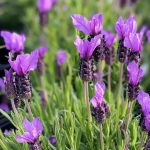 Sold Out
Sold Out
Lavender stoechas, is distinguished from other lavenders by its unusual flower blossoms. The flowers are typically purple, although they can also be pink or white, and are topped with distinctive “rabbit ears” or bracts that resemble wings.
Stoechas is used ornamentally in the garden and the flowers may be used to make Lavender sachets, Lavender wreaths and other dried floral arrangements. The flowers of Lavandula stoechas may be dried and used just like any others in the species.
Spanish lavender is native to the Mediterranean region and is a perfect fit for a Mediterranean-style garden. Combine it with other Mediterranean plants like rosemary, thyme, and sage for a garden that is both beautiful and functional.
Flowering: Spring [September - December]
Fruiting:
Leptinella dioica (Shore Cotula)
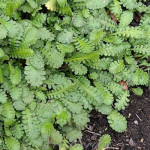
Leptinella dioica is an herbaceous perennial native to New Zealand. It is a creeping and somewhat fleshy plant that bears small and green, fern-like leaves with a touch of bronze. Small, yellow flowers are borne through spring and summer amidst the foliage. It typically grows to 10 cm tall and 70 cm wide, growing best when planted on a well-drained site in full sun or partial shade. This hardy plant has storage roots which enable it to survive moderate frosts, dry periods, and coastal environments. This is a great plant to use as a low groundcover, for planting between rocks and pavers, using in tropical gardens, or planting around pool areas. Can be used as a lawn substitute in low traffic areas which are seasonally damp or somewhat poorly drained. Tolerates sun, wet and dry periods and salt water. Will grow on clay banks. Evergreen. Hardy.
Habitat: Coastal and inland up to 1000 m a.s.l.. In the northern part of its range usually on the margins of saltmarshes but further south extending well inland in seepages and permanently open, damp turfs.
Flowering: Spring - Summer [August - January]
Fruiting: Summer - Autumn [October - June]
Leptinella filiformis (Slender Button Daisey)
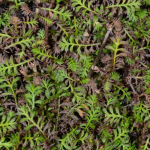
Leptinella filiformis is a tight mat of fine fern-like aromatic leaves. Good for lawns. Part shade, open areas / White button flower. Hardy
Habitat: A species of lowland to montane (300-600m a.s.l.) basins, plains, hills and valley floors where it grows in grasslands, open shrubland, and under open Kanuka canopy. In the remaining wild population it lives in mostly open areas which are muddy in Winter but baked dry in Summer.
Flowering: Spring - Summer [November - February]
Fruiting: Summer - Autumn [December - May]
Leptinella squalida (Brass Buttons)
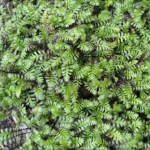
Leptinella squalida, Brass Buttons, is a gray-green creeper with little green leaves that resemble fern fronds. A dense mat-forming perennial, Leptinella squalida turns bronze in autumn. Sometimes called New Zealand Brass Buttons, its tiny yellow button blooms often go unnoticed. It will tolerate moderate foot traffic. Leptinella squalida prefers partial shade to shade and well draining soil.
Habitat: Mostly coastal or inland (0-300 m a.s.l.), in open turf, on coastal cliffs, in coastal turf, along river beds or in open grassland and open, damp places within shrubland and lowland forest.
Flowering: Spring - Summer [August - February]
Fruiting: Summer - Autumn [December - June]
Leptinella squalida Platts Black (Brass Buttons)
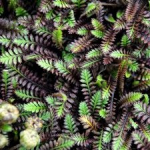
Leptinella squalida Platts Black is a low growing, herbaceous perennial commonly used as a groundcover. It features feathery, bronze-black foliage and typically grows to 10 cm tall. It spreads quickly via its root system and will reach 50 cm wide inside of two growing seasons. Best results with this plant are achieved when it is grown on a well-drained site that does not dry out, and in full sun to retain its darker colouring. It will tolerate dry periods, moderate frost, and heavy soils. Platts Black is commonly used as an attractive groundcover, particularly where something low growing and vigorous is required. It is perfect for planting along the edge of pathways or between flagstones and pavers.
Flowering: Spring - Summer [August - February]
Fruiting: Summer - Autumn [December - June]
Leptospermum scoparium (Manuka, Tea Tree)
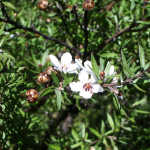
Leptospermum scoparium, the Manuka tree (or Tea Tree), is a fast growing shrub with abundant white flowers in Summer. The flowers are attractive to bees. Both manuka and kanuka are used as a nurse crop with other early colonizing plants for revegetation / restoration planting and are also very effective in erosion control.
Mānuka is often confused with the related species kānuka (Kunzea ericoides) – the easiest way to tell the difference between the two species in the field is to feel their foliage – mānuka leaves are prickly, while kānuka leaves are soft. Alternatively, the seed capsules of mānuka are large (5–7 mm in diameter) and often remain on the plant year round, whereas the seed capsules of kānuka are much smaller (2.2–4.6 mm in diameter) and are not present for much of the year.
History of use: The wood was often used for tool handles. Mānuka sawdust imparts a delicious flavour when used for smoking meats and fish. It is cultivated in Australia and New Zealand for mānuka honey, produced when honeybees gather the nectar from its flowers, and for the pharmaceutical industry. An essential oil, for which many medicinal claims are made, is produced by steam distillation of its leaves.
Habitat: Abundant from coastal situations to low alpine habitats.
Flowering: Spring - Summer [September - March]
Fruiting: Autumn - Summer [Throughout the year]
My Lists: Erosion Control, Wetland, Pioneer Species
Libertia cranwelliae (Mikoikoi, NZ Iris)
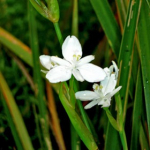
Libertia cranwelliae, commonly called Mikoikoi, has strap-like leaves along a wide-spreading rhizome. White flowers in spring on short spikes. Attractive orange pods remain on the plant for months. Commonly mass planted.
Flowering: Spring [September - November]
Fruiting: Summer - Winter [December - April]
Libertia grandiflora (Mikoikoi, NZ Iris)
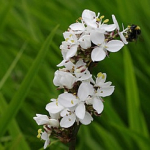
Libertia grandiflora, or Mikoikoi, is the largest of the New Zealand Irises . Tall stems of pure white flowers are held up above the leaves in spring. These are followed by attractive golden seed capsules.
Habitat: Coastal to montane. Usually in open, lowland forest remnants, forest margins, on steep slopes, ridgelines, bluffs, cliffs, stream banks, and river terraces.
Flowering: Spring - Summer [September - November]
Fruiting: Autumn [December - April]
Libertia ixioides (Mikoikoi, NZ Iris)
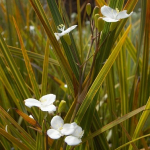
Libertia ixioides, commonly known as "Golden Libertia" or "Mikoikoi," is a perennial evergreen plant that belongs to the family Iridaceae. It is native to New Zealand, particularly in the North Island and the northern part of the South Island. Libertia ixioides is known for its striking appearance and is a popular choice for landscaping and ornamental purposes.
The foliage of Libertia ixioides consists of slender, sword-like leaves that grow in fan-like arrangements. The leaves are typically bright green in color and can reach a height of up to 60 centimeters tall. They have a rigid, upright form and add a dramatic vertical element to the landscape.
One of the most distinctive features of Libertia ixioides is its flowers. The flowers are typically arranged in clusters on tall, wiry stems that rise above the foliage. The flowers are usually white or cream-colored, although they can also be yellow, and have six petals that are arranged in a star-like shape. The flowers are small, typically measuring about 1 to 2 centimeters in diameter, but they are abundant and create a stunning display when in bloom.
Libertia ixioides is a hardy plant that is well-suited for coastal gardens and can tolerate a wide range of soil types. It prefers full sun to light shade and is drought-tolerant once established. It is a clump-forming plant and attractive groundcover.
In addition to its aesthetic appeal, Libertia ixioides also provides habitat and food for pollinators such as bees and butterflies. It is relatively low-maintenance, requiring minimal pruning and care. Overall, Libertia ixioides is a visually striking and adaptable plant that adds a touch of elegance to any garden or landscape.
Habitat: Coastal to montane. Often locally common on ridges, cliffs, gullies, river banks, coastal cliffs, and upland forest.
Flowering: Spring [September - December]
Fruiting: Summer - Winter [January - April]
Libertia peregrinans (Mikoikoi, NZ Iris)
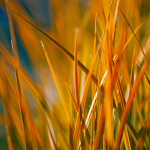 Sold Out
Sold Out
Libertia peregrinans, commonly known as Mikoikoi, is a NZ Iris that has stiff golden coloured leaves. The flowers are pure white and are held on stems amongst the leaves. Spreads by means of underground runners, forming large clumps.
Habitat: A primarily coastal or lowland species of sandy, peaty or pumiceous soils. It may be found growing in dune slacks and swales, on the margins of swamps, in open poorly draining ground under scrub.
Flowering: Spring [October - January]
Fruiting: Summer [January - February]
Ligustrum rotundifolium (Japanese Privet)
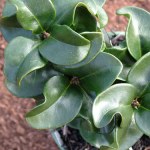
Ligustrum rotundifolium, commonly called Japanese Privet, is a compact shrub with thick, glossy, rounded wavy leaves. Makes an ideal specimen plant in containers and a great chunky-looking hedge. Bears large panicles of cream flowers in summer followed by black berries.
Commonly known as round-leaved privet, an evergreen shrub native to East Asia, particularly China and Japan, it is widely cultivated for its ornamental value.
Ligustrum rotundifolium is a medium-sized shrub that produces small, white, fragrant flowers in late spring or early summer. The flowers are borne in clusters called panicles and attract pollinators such as bees and butterflies. After flowering, this shrub forms small, black berries that ripen in late summer or fall. The berries are attractive to birds.
Ligustrum rotundifolium is often used as an ornamental shrub in landscapes and gardens. It is suitable for hedges, borders, foundation plantings, and can be trained into topiaries or screens. Relatively low-maintenance. It prefers full sun to partial shade and well-drained soil. Pruning can be done to maintain its shape and promote dense growth.
Flowering: Spring [October - December]
Fruiting: Summer [January - March]
Liriope muscari (Purple Liriope)
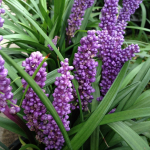
Liriope muscari Royal Purple is a clumping ground-cover with rich, grass-like leaves. Dark-purple flowers from early summer to autumn. Prefers well-drained soil and partial shade. Great for under-planting as a tropical effect.
Flowering: Summer - Autumn [December - May]
Fruiting:
Liriope muscari Monroe White (White Liriope)
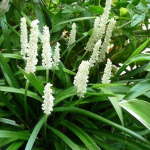 Sold Out
Sold Out
Liriope muscari Monroe White has solid green leaves approximately 30-35 cm long with clustered spikes of white flowers. Clumps spread moderately. Prefers partial to full shade, well drained soil and protection from the wind. Tolerates dry periods. Lovely as a border or groundcover.
Flowering: Summer - Autumn [December - May]
Fruiting:
Liriope muscari Samantha (Pink Liriope)
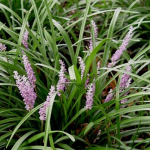 Sold Out
Sold Out
Liriope muscari Samantha a very hardy grass like plant with a profusion of pink flower spikes in late spring and early summer. Prefers well drained soil in a sunny or partly shaded position.
Flowering: Summer - Autumn [December - May]
Fruiting:
Lithodora Grace Ward
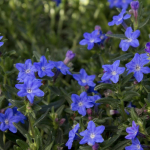 Sold Out
Sold Out
Lithodora Grace Ward is a hardy, ground-covering perennial that forms a dense mat of dark-green foliage all year round. This plant is known for its exquisite, blue starry flowers that bloom from spring through summer.
Ideally suited for rockeries, walls and banks, this plant thrives in full sun and free-draining soil. Its low trailing habit makes it a versatile choice for various garden styles, including Mediterranean, coastal and city gardens. Virtually disease and pest-free and attracts butterflies, adding ecological value to your garden.
Flowering: Spring - Summer [October - February]
Fruiting:
Lobelia angulata (Panakenake, Pratia Angulata)

Pratia angulata, now known as Lobelia angulata or Panakenake, is a low-growing perennial plant that belongs to the Campanulaceae family. It is native to New Zealand and Australia and is known for its attractive, star-shaped blue flowers and dense mat-like growth habit.
The leaves of Pratia angulata are small, opposite, and rounded, measuring about 1-2 centimeters in diameter. They are glossy, dark green in color, and have serrated edges. The stems are creeping and angular, hence the species name "angulata," and can grow up to 30 centimeters in length.
The most distinctive feature of Pratia angulata is its flowers. The flowers are solitary and have five blue petals fused at the base, forming a star-like shape, hence the common name "Blue Star Creeper." The flowers are usually about 1-1.5 centimeters in diameter and have a yellow center. They are profuse bloomers and appear in spring and summer, attracting pollinators like bees and butterflies.
Pratia angulata is a ground-covering plant that forms a dense, spreading mat of foliage, making it an excellent choice for use as a lawn substitute or as a ground cover in rock gardens, between stepping stones, or in other areas where a low-growing plant is desired. It prefers partial to full sun and well-draining soil, and it can tolerate some foot traffic. Pratia angulata is considered a hardy plant and is relatively low-maintenance, making it a popular choice for landscape use in suitable climates. Dies back in winter in cold winter areas.
Habitat: Found in damp, sheltered paces up to 1,500m.
Flowering: Spring - Summer [October - March]
Fruiting: Autumn [February - April]
Lomandra Lime Tuff
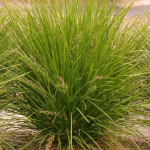 Sold Out
Sold Out
Lomandra Lime Tuff is a small variety of Lomandra that only grows to between 40cm and 50cm in height and width. A compact grass with fine, lime-green foliage that retains its colour throughout the year and produces small yellow flower spikes in summer. Hardy and tolerates frost, dry conditions and thrives well in part shade to full sun. Tolerates most types of soil and is suitable for mass planting as a groundcover. Ideal for growing in coastal conditions.
Flowering: Summer [December - February]
Fruiting: Summer [February]
Lonicera nitida (Box Honeysuckle)
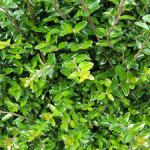
Lonicera nitida, commonly known as the Box Honeysuckle, is a hardy shrub often used instead of Buxus. It carries dense, upright branches which host small and glossy, dark green leaves. New growth has attractive, purple-black edges. Red/purple tones in winter. Small creamy white fragrant flowers in summer. It typically grows to 2 m tall and 1 m wide and can be trimmed as necessary. The Box Honeysuckle makes for a lovely backdrop for smaller plants and is commonly used for hedging and topiary. Fast growing and hardy.
Best results with this evergreen are achieved when it is planted in full sun or partial shade on a well-drained site. It is tolerant of frost, cool climates, coastal conditions, and dry periods.
Flowering: Summer [December - February]
Fruiting:
Lophomyrtus Kathryn
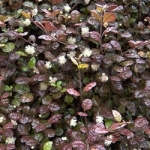 Sold Out
Sold Out
Lophomyrtus Kathryn is a fast growing N.Z. native shrub. Has oval, purplish-brown leaves, with a puckered upper surface - colour darkens during colder months. Bearing creamy-white flowers followed by purple berries.
Prefers a sunny or partially shaded position in well-drained soil. Tolerates moderate frosts. Responds well to clipping. Attractive contrasting plant. Widely used for hedging purposes. Foliage suitable for floral art.
Flowering: Summer [December - February]
Fruiting:
Lophomyrtus obcordata (Rōhutu)
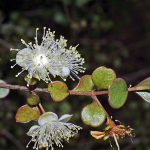
Lophomyrtus obcordata is a bushy shrub with a corded smooth trunk under flakes of bark bearing small thick heart-shaped leaves.
Habitat: Occasionally dominant in alluvial forest remnants of the eastern South Island.
Flowering: Summer [November - March]
Fruiting: Autumn [January - May]
Machaerina rubiginosa (Baumea, Rush)
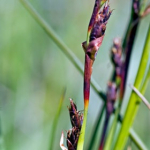 Sold Out
Sold Out
Machaerina rubiginosa, is a vigorous creeping species best used for the revegetation of wetlands. It is found in swampy places throughout the North and South Island. The rush-like leaves are up to 1m or more tall and are bluish to dark green with flowering spike-lets of reddish brown. It needs full sun, ample moisture and plenty of space. Good for erosion control and contaminated / nutrient filled water.
The upright foliage and spreading rhizomatous habit allow the plant to form large dense swards in wet areas. It can grow in water up to a depth of around 50 centimetres. The plant tends to grow taller in permanently damp areas and shorter in ephemeral environments. It is suitable for use in artificial wetlands.
Habitat: Coastal to montane (up to 900 m a.s.l.) in most freshwater wetlands; especially favouring low moor peat bogs, the margins of restiad bogs and their burn pools, more rarely on the margins of lakes, tarns and slow-flowing streams.
Flowering: Spring [October - December]
Fruiting: [Throughout the year]
My Lists: Erosion Control, Wetland
Melicytus alpinus (Porcupine Shrub)
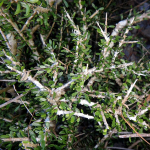
Melicytus alpinus get their common name, porcupine shrub, from the long, almost leafless, spindly branches which resemble the quills of a porcupine. Its leaves are narrow and generally have smooth margins with a few exceptions with serrated edges, however, they do only have a small amount of leaves and they are only approximately 1cm long. Hard and dense, slow-growing in coastal or alpine areas of southern North Island and the South Island it looks almost leafless. But most of the leaves are sheltered between the stiff interlacing stems as an adaptation to the harsh environment where the plant grows. Leaves are variable, leathery.
Melicytus alpinus is very well adapted to extreme weather conditions such as drought, which is why it can be found in areas such as the heavily modified high country of the South Island.
Melicytus alpinus is a habitat to many lizards endemic to New Zealand, this group of lizards include both skinks and geckos. This relationship is mutually beneficial as the lizards use the porcupine shrub as protection from weather and/or predators and in turn eat and spread the seeds from the shrub's berries.
Habitat: Occurs east of the Southern Alps in exposed rocky places between 600m and 1.300m. Found in the wild on very light sand or rocky soils, or on rock outcrops in full sun though it grows on any well-drained soil.
Flowering: Summer [November - January]
Fruiting: Autumn [February - April]
My Lists: Rare Plants
Melicytus crassifolius (Thick-leaved Mahoe)
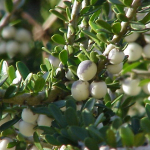
Melicytus crassifolius is heavily-branched, with arching stems that taper at the tips to a sharp point. The small bright olive green leaves are teardrop shaped. It has small, greenish, bell-shaped flowers which appear underneath branches in summer, They form in clusters along the branches. The fruit is small bright white berries and they develop late summer until early winter. Usually, a blue spot appears on the berry with age.
Habitat: This compact hard shrub is endemic to both the North and South Island where it is typically found along coastal lowlands (0-300 m a.s.l.). Usually coastal in open grey scrub, on talus and alluvial terraces, cobble beaches, cliff faces, and in coarse stable sand dunes (especially swales). Inland it may be found in open grassland, amongst kanuka stands and along river flats.
Flowering: Summer [August - January]
Fruiting: Autumn [October - May]
Melicytus ramiflorus (Mahoe, Whiteywood)
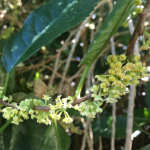 Sold Out
Sold Out
Melicytus ramiflorus, commonly known as Whiteywood or Mahoe, is one of our most common trees, found in forest and shrub throughout New Zealand and growing quickly to 5m or more. The pointed oval leaves are a bright green, with fresh growth being quite soft and an even brighter green. The bark is greyish white and becomes attractively mottled with lichens. Flowers in spring followed by numerous purple black berries. Whiteywood can be clipped for hedging or used as a shelter tree or filler, and will also make quite an attractive specimen. Avoid heavy frosts when young.
The berries of Māhoe are eaten by a number of native birds, including kererū and tui, and some geckos. It is frequently seen in areas of regenerating forest, particularly in areas of disturbed soil. Its early appearance in regenerating forests indicates that it is ideal for revegetation plantings.
Habitat: Abundant small tree of coastal, lowland, and lower montane forests throughout the country.
Flowering: Spring [November - February]
Fruiting: Summer [February - May]
Michelia Figo (Port Wine Magnolia)
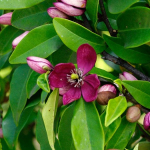
Michelia Figo, otherwise known as Port Wine Magnolia, is a popular evergreen shrub or small tree with glossy green oval leaves. It has masses of sweet port wine scented flowers in spring through to summer which provide a delightful fragrance for the garden. It prefers a rich, well drained soil in a sheltered spot. Good choice for hedging and screening.
Flowering: Spring - Summer [September - February]
Fruiting:
Muehlenbeckia astonii (Pohuehue)
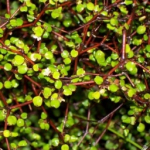
Muehlenbeckia astonii, Pohuehue, is a coastal divaricating shrub with a wiry interlacing habit. Small, bright-green heart-shaped leaves. This plant is extremely hardy, tolerating dry conditions and wind. Popular landscaping plant, providing great contrast. Makes an attractive topiary or hedge. Attracts birds, insects and lizards. Semi-deciduous. Hardy.
Unlike most New Zealand plants M. astonii is leafless in winter. This is when the distinctive branches add interest to the garden. It grows from a distinct trunk and has many fine reddish-brown to orange flexible branches that zigzag around one another to form a dense, interwoven ball. Its flowers, appearing from December to January, are tiny and are greenish to white or pinkish white. The fruits are sweet and edible, eaten by birds and lizards. The plant is an important host for several endemic insect species and in some cases their sole host.
Habitat: Coastal to lowland. This species is associated with “grey” scrub communities, largely confined to drier lowland parts of eastern New Zealand. It is found on moderate to high fertility soils. Its deep root system helps it survive in dry conditions, and can grow on open rocky hillsides and stony ground. It prefers free-draining, warm, sunny slopes, such as the mid-dune areas along the coast. The plant is often found in association with Coprosma crassifolia, Coprosma propinqua, Muehlenbeckia complexa, Discaria toumatou, Olearia solandri and Ozothamnus leptophyllus.
Flowering: Spring - Summer [August - January]
Fruiting: Summer - Autumn [October - April]
Muehlenbeckia axillaris (Creeping Pohuehue)
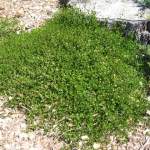 Sold Out
Sold Out
Muehlenbeckia axillaris, commonly known as Creeping Pohuehue or wire vine, is a low dense ground cover, forming wiry mats up to about 1 m in diameter. It spreads along the ground and even underground. It flowers prolifically in summer with masses of small creamy flowers. The flowers are yellowish white, 4-8 mm in diameter, and borne in groups of up to 3 in the axils. Male and female flowers often occur on the same plant and the female flowers form small opaque white fruit. Provides habitat for native copper butterflies. Birds and geckos love the fruit.
This groundcover has stems and small dark green leaves. Muehlenbeckia axillaris has thin wiry red-brown stems, with small dark green leaves that are less than 1 cm in diameter, and 2–4 mm thick. Prefers full sun. Tolerant of hot, dry conditions. Evergreen. Hardy.
Muehlenbeckia axillaris is primarily grown as an ornamental plant for its unique growth habit and attractive foliage. It is often used in rock gardens, coastal gardens, or other landscapes where its trailing habit can be appreciated. It is also used in erosion control and habitat restoration projects due to its ability to stabilize soil and provide cover for wildlife.
Habitat: Found in subalpine rocky places, riverbeds and and grasslands.
Flowering: Summer [November - April]
Fruiting: Autumn [December - April]
My Lists: Erosion Control
Muehlenbeckia complexa (Scrambling Pohuehue)
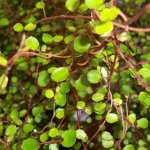
Muehlenbeckia complexa, commonly called scrambling or small-leaved Pohuehue, is quite vigorous and probably the best species for trimming and topiary. It is semi-deciduous, losing most, or all of its leaves over winter. Grows to 4m or more up suitable supports, and produces swollen white berries with black seeds. Leaves turn bronzy before dropping in late fall/early winter. Any reasonably well drained soil will suit this agreeable groundcover, and it'll tolerate drought, salt spray, and wind. Often found growing in the company of Plagianthus divaricatus.
M. complexa can form dense springy mounds, useful for suppressing weeds. In its native environment, it plays a key role in sealing human and natural disturbances on the forest edge. It also suppresses the growth of introduced weeds, such as blackberry, and promotes increased insect diversity. A wide variety of insect species are associated with M. complexa. It is an important host plant for several endemic species of copper butterflies including the coastal copper (Lycaena salustius). It is also a food source for lizards and birds such as tui, bellbird and kererū, which also feed on the buds and leaves.
Habitat: Found along rocky coasts as well as inland in coastal and montane forests.
Flowering: Spring - Autumn [October - February]
Fruiting: Winter [March - June]
My Lists: Erosion Control
Myrsine australis (Mapou, Red Matipo)
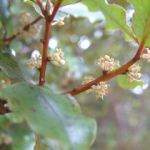 Sold Out
Sold Out
Myrsine australis, or Red Matipo, forms a handsome large shrub or tree with distinctive red branchlets and wavy leaf margins. Similar in appearance to Pittosporum tenuifolium. The cream flowers and later the black fruit are in clusters below the leaves. Used as a specimen, shrub border or hedge.
Habitat: Occurs in lowland forests. Common tree of regenerating and mature forest in coastal to montane situations.
Flowering: Spring - Summer [September - February]
Fruiting: Autumn [February - May]
Myrsine divaricata (Mapou, Weeping Matipo)
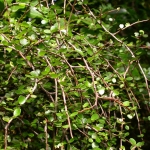
Myrsine divaricata is a small evergreen, bushy shrub, with spreading, drooping branches, which can grow to 6m high. The drooping branches give rise to woody interlacing (divaricating) branchlets bearing solitary leaves or leaves in groups. Tiny flowers, with pale yellow or red petals, occur in clusters. Evergreen.
Habitat: Found in subalpine scrub and forests, preferably where the ground is moist.
Flowering: Winter [June - November]
Fruiting: Spring - Autumn [August - April]
Myrtus ugni (NZ Cranberry, Chilean Guava)
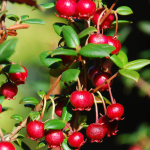
Myrtus ugni, commonly called NZ Cranberry or Chilean Guava, is a dense small shrub popular for hedging and the masses of dark red edible fruits that follow delicate pink flowers produced in summer. Great as an edging plant around vege gardens or to make a formal border around the garden. Clip to maintain height and shape. Self-fertile. Ripens February-March.
Native to Chile, Argentina. A favorite of Queen Victoria, who tried her best to promote it in the 19th century. As the scent of Chilean Guava is intoxicating, grow this terrific plant where you can enjoy its wonderful fragrance and pick its sweet fruits.
Flowering: Summer [December - February]
Fruiting: Autumn [March - May]
Nandina Firepower (Heavenly Bamboo)
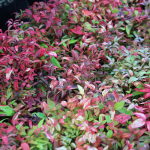
Nandina Firepower is a compact growing shrub with year-round foliage interest. The paper like leaves are almost lime green in summer, colouring well in autumn. Looks fantastic as a small border or hedge, but equally as good as a change of colour in the garden.
If planted in shade it will normally grow OK but the protected environment will stop the great colors appearing in winter - the leaves will stay green. Evergreen. Hardy.
Flowering: Summer [December - February]
Fruiting: Autumn [March - April]
Nandina Gulfstream (Heavenly Bamboo)
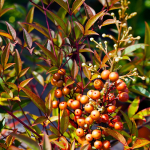
Gulfstream is one of the best compact shrubs for year-round foliage interest. It features a variety of leaf colors on a fairly dense, evergreen plant. Graceful foliage in tones of green, purple, orange and red which intensify in winter. New growth is bronze with orange tints.
Flowering: Summer [December - February]
Fruiting: Autumn [March - April]
Olearia adenocarpa (Small-leaved Tree Daisy)
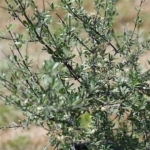
Olearia adenocarpa is a critically endangered species, threatened by browsing animals and habitat loss. A spreading, small leaf shrub with fragrant flower. Clip to keep compact. Withstands harsh, drought-prone places. Only found on a few sites on dry rocky old river channels near the Waimakariri and Rakaia Rivers.
As part of the dry woodland community, it plays an important role in conditioning the soil. The soil conditioning creates a more hospitable environment for less robust species and broadleaf/podocarp forest succession. Other plants in this community include but are not limited to Discaria toumatou, Poa cita, Ozothamnus leptophyllus, Corokia cotoneaster, Melicytus alpinus and Cordyline australis.
Habitat: A lowland species of recently deposited alluvial gravels and sands. Generally grows in degraded to unimproved dry grassland along the dry stony terraces and channels that border a braided riverbed.
Flowering: Summer [January - February]
Fruiting: Autumn [February - March]
My Lists: Rare Plants
Olearia arborescens (Pekapeka, Common Tree Daisy)
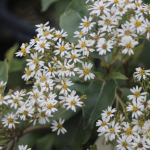 Sold Out
Sold Out
Olearia arborescens is a bushy small tree bearing leathery oval pointed dark green glossy leaves that are paler underneath and large clusters of white daisy-like flowers in Spring to early Summer that develop into fluffy seeds. Leaves variable, 4-8cm long, longer than wide, edge with a few small sharp bumps. The trunk has thin, papery bark which peels in long thin flakes. During spring and summer, it has white flower heads with 15-20 individual flowers (up to 15 mm) on each. Flower petals are white and the centre pale yellow. Hardy, but prefers well-drained or even dry site.
Habitat: Occurs in forest and shrublands in lowland and montane environments. It grows in lowland to alpine scrubland in the North Island from East Cape southwards, and throughout the South and Stewart Islands.
Flowering: Spring - Summer [October - January]
Fruiting: Summer - Autumn [December - March]
Olearia avicenniifolia (Mountain Akeake)
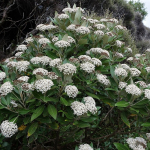
Olearia avicenniifolia, or Mountain Akeake, is an autumn flowering shrub - sweet showy, daisy like flowers. Silver / green large leaf. Very hardy bushy shrub tolerates exposure and dry sites.
Habitat: Occurs in scrub from sea-level to 900m.
Flowering: Autumn [January - April]
Fruiting: Autumn [February - May]
Olearia lineata (Small-leaved Tree Daisy)
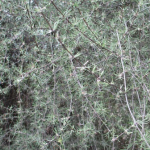
Olearia lineata is one of the best native plants for hedging with fine grey, willowy foliage. Fast growing and hardy, forming a graceful tree, bearing masses of erect twigs with clusters of small very thin leaves that are white underneath, on the margins of steep river gorges and amongst rocky outcrops. Bushy tree up to 6m tall with a fragrant white flower. Evergreen. Hardy.
Habitat: A rare, at-risk and in decline tree endemic to the South Island of New Zealand. Found mostly in the east in damper sites from lowland to 300m above sea level. Found on tussock grassland and forest margins, river terraces. Also found on the margins of steep river gorges, and amongst rock outcrops, boulder field and at the toe of alluvial fans.
Flowering: Summer [November - January]
Fruiting: Autumn [January - April]
My Lists: Rare Plants
Olearia lineata Dartonii (Twiggy Tree Daisy)
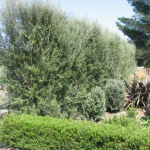
Olearia lineata Dartonii is a small, open-branched tree with plume-like branches and fine leaves. Trims well for fast hedging and shelter. Fragrant white flowers.
Flowering: Summer [December - February]
Fruiting:
Olearia nummulariifolia (Tree Daisy)
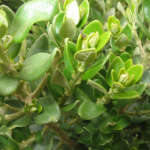
Olearia nummulariifolia is a medium-sized, much-branched, box-like shrub. It's stiff branches give the bush an unusual appearance. Olearia nummulariifolia has small closely set yellow-green leaves (5-10mm long and 4 -6 mm wide). They are leathery, very thick and small roundish (coin-shaped hence the specific name) leaves that have a brownish tomentum underneath.. Its daisy flowers appear in spring through to autumn on the branch tips. Ideal for low hedging.
Habitat: It is found in alpine dry and open situations usually at 600–1,400 m, from Lat 37 degrees 30 minutes southwards throughout New Zealand descending to lowlands in the southern part of its range.
Flowering: Summer [November - April]
Fruiting:
Olearia paniculata (Akiraho, Golden Akeake)
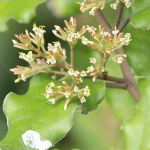
Olearia paniculata, Akiraho, is a rounded small tree with yellowish-green wavy leaves. Flowers small, white, in dense clusters. Fragrant sweet-scented flowers are borne in autumn. A good shelter plant. Hardy and tolerant of coastal conditions.
Due to its attractive appearance and hardiness, Olearia paniculata is sometimes cultivated as an ornamental shrub in gardens and landscapes. It can be utilized as a hedge, specimen plant, or included in mixed border plantings.
Habitat: Found in scrub east of East Cape to south Canterbury
Flowering: Autumn [March - May]
Fruiting: Winter [April - July]
Olearia traversii (Hakapiri, Chatham Island akeake)
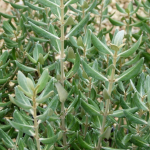
Olearia traversii is a tough, fast-growing coastal tree excellent for hedging or shelter on dry, exposed sites.
Habitat: A tree common of lowland forests, now most commonly found on dune systems. It also occurs along the edge of larger lagoons and lakes (but only in free draining soils) and sometimes on cliff tops.
Flowering: Summer [November - February]
Fruiting: Autumn [January - June]
Olearia x oleifolia (Daisy Bush)
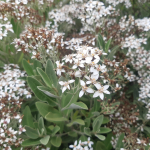
Compact, flowering shrub. Excellent in dry and partially shaded situations. A mass of scented white flowers in summer. Originates from Canterbury’s Rangitata Gorge. Evergreen. Hardy.
Flowering: Summer [December - February]
Fruiting:
Ophiopogon japonicus (Green Mondo Grass)
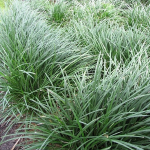
Ophiopogon japonicus, commonly called Green Mondo, has grass-like clumps of dark green strappy foliage with small spray of lilac flowers followed by blue berries. Best grown in free draining soil in sun or semi shade. Height and width to 30 cm. Ideal for borders, pots and as a ground cover. Evergreen. Hardy.
Flowering: Summer [December - February]
Fruiting: Autumn [March - May]
Ophiopogon japonicus Kyoto (Dwarf Mondo Grass)
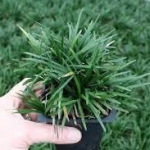
Ophiopogon japonicus Kyoto is a very low maintenance dwarf mondo grass that clumps to 5 cm in height with short dark green curving foliage and tiny white flowers within the foliage in summer. Suitable for a range of soils. It is very frost hardy and tolerates sun to semi-shade. Excellent for edging or underplanting. Evergreen. Hardy.
Flowering: Summer [December - February]
Fruiting: Autumn [March - May]
Ophiopogon japonicus Nana (Dwarf Mondo Grass)
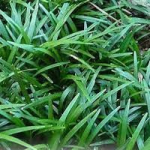
Ophiopogon japonicus Nana, commonly called Dwarf Mondo Grass, is a miniature clump forming evergreen grass that spreads to form a dense carpet of dark green foliage offset by spike of lilac flowers followed by blue berries. Height to around 10 cm. A very hardy and low maintenance plant that prefers part to full shade but will tolerate full sun. Excellent for garden edging, ground cover and underplanting ground or container shrubs. Evergreen. Hardy.
Flowering: Summer [December - February]
Fruiting: Autumn [March - May]
Ophiopogon planiscapus (Green Mondo Grass)
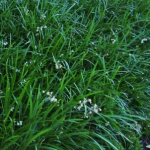
Ophiopogon planiscapus, also known as Green Mondo Grass, grows grass-like clumps of dark green strappy foliage with small spray of lilac flowers in summer followed by blue berries in autumn. Best grown in free draining soil in sun or semi shade. Height and width to 30 cm. Ideal for borders, pots and as a ground cover.
Flowering: Summer [December - February]
Fruiting: Autumn [March - May]
Ophiopogon planiscapus Black Dragon (Black Mondo Grass)
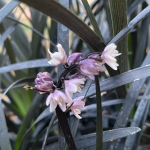
Ophiopogon planiscapus Black Dragon, commonly called Black Mondo Grass, is a clumping evergreen perennial with distinctive deep purple-black foliage. In summer, small sprays of lilac/pink flowers are followed by black fruits. Slow growing. Prefers free draining soil. Stunning effect in mass plantings. Excellent border or edging plant or as underplanting in garden or container. Evergreen. Hardy.
Flowering: Summer [December - February]
Fruiting: Autumn [March - May]
Ophiopogon planiscapus Hosoba Kukuryu (Dwarf Black Mondo Grass)
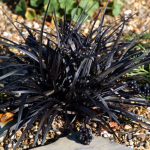
Ophiopogon Hosoba Kukuryu is slow spreading evergreen perennial, forming dense clumps of upright, narrow, grass-like, purplish-black leaves 10cm in length. Racemes of small pale purplish-white flowers, in summer, followed by fleshy, blue-black berries. Evergreen. Hardy.
Flowering: Summer [December - February]
Fruiting: Autumn [March - May]
Ozothamnus leptophyllus (Tauhinu, Cottonwood)
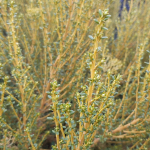 Sold Out
Sold Out
Ozothamnus leptophyllus, commonly called Tauhinu or Cottonwood, is a bushy shrub with small yellow green leaves. It has an attractive golden appearance and flowers in profusion with clusters of tiny cream daisy (wheel-shaped) flowers followed by down-covered seed heads. It is fast-growing, reaching its maximum height of 2 metres in 10–15 years.
Tauhinu can readily colonise bare hillsides and pasture, with seeds readily dispersed by the wind. It grows rapidly, acting as a nursery plant for other species. Unless their under storey plants are heavily grazed, Tauhinu shrublands are usually overtopped by taller shrubs and trees. Because of this, Tauhinu makes an excellent coastal or dry woodland revegetation plant. It prefers a sunny location and is frost hardy.
Habitat: Found in coastal to subalpine shrubland.
Flowering: Summer [December - March]
Fruiting: Autumn [March - April]
My Lists: Pioneer Species
Pachysandra terminalis (Japanese Spurge)
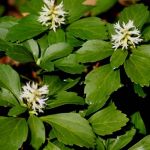 Sold Out
Sold Out
Pachysandra terminalis, commonly known as Japanese Spurge or simply Pachysandra, is a perennial evergreen ground cover plant that belongs to the boxwood family (Buxaceae). It is native to Japan and China and is widely used in landscaping and gardening for its attractive foliage and ability to form dense mats that suppress weeds.
During late winter to early spring, Pachysandra terminalis produces small, white, fragrant flowers on short spikes that rise above the foliage. The flowers are unisex and can be either male or female, though they are usually inconspicuous. The fruit that follows is a small, rounded, fleshy capsule containing seeds.
Pachysandra terminalis is a shade-loving plant and thrives in moist, well-drained soils. It is often used as a ground cover in shady areas where other plants may struggle to grow, such as under trees or along the edges of woodland gardens. It forms dense, weed-smothering mats that help to prevent erosion and inhibit the growth of other plants. It is a slow-growing plant and generally low-maintenance, requiring minimal care once established.
Overall, Pachysandra terminalis is a popular and versatile ground cover plant that adds year-round greenery to shady areas and provides an attractive, low-maintenance option for landscaping and gardening projects. Has spikes of white flowers in spring which - an early food source for bees.
Flowering: Spring [October - November]
Fruiting:
Penstemon
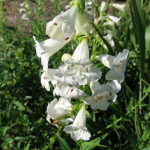
Penstemon is a free-flowering perennial with lush, long pointed leaves. Forms a dense bushy shrub and is relatively hardy. Tall flower spikes hold masses of tubular flowers.
Deadhead to maintain the vigour of the plant and encourage further flowering. Leave foliage on over winter to prevent damage from frost and then cut back in early spring which will encourage new growth.
Flowering: Spring - Summer [September - February]
Fruiting:
Phebalium squameum (Satin Wood)
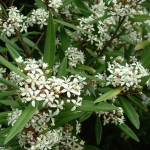
Phebalium squameum is a hardy tree that can be planted in full sun or part shade. It produces small, white, scented flowers during the spring, making it a great choice for use in hedging or as a specimen in a small garden. Once established, Phebalium squameum is tolerant of wind, coastal sites, and dry periods.
Flowering: Spring [September - November]
Fruiting:
Phlox subulata Daniel (Moss Phlox Pink Flower)
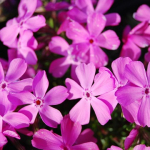
Phlox subulata is a variety of creeping phlox, or moss phlox, that boasts flashy pink flowers with dark green glossy foliage and a wonderful compact growth habit. Phlox subulata is a vigorous, spreading, mat-forming, sun-loving phlox that is noted for its creeping habit, its needle-like leaves and its profuse carpet of mid-spring flowers with notched flower petals. Beautiful draping over a rock wall or along garden paths. For a white flowering version see Phlox subulata White.
Creeping phlox is most renowned for its profuse bloom lasting 3-4 weeks in mid to late spring, when it is covered in flowers, creating a vibrant, carpet-like display. Once established, it has good drought tolerance, making it a low-maintenance option for your garden.
Flowering: Spring [September - December]
Fruiting:
Phlox subulata White (Moss Phlox White Flower)
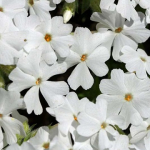
Phlox subulata is a variety of creeping phlox, or moss phlox, that boasts flashy white flowers with dark green glossy foliage and a wonderful compact growth habit. Phlox subulata is a vigorous, spreading, mat-forming, sun-loving phlox that is noted for its creeping habit, its needle-like leaves (which retain some green in winter) and its profuse carpet of mid-spring flowers with notched flower petals. Beautiful draping over a rock wall or along garden paths.
Creeping phlox is most renowned for its profuse bloom lasting 3-4 weeks in mid to late spring, when it is covered in flowers, creating a vibrant, carpet-like display. Once established, it has good drought tolerance, making it a low-maintenance option for your garden.
Flowering: Spring [September - November]
Fruiting:
Phormium Black Rage (Black Flax)
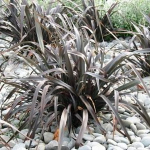 Sold Out
Sold Out
Phormium Black Rage is a stunning, evergreen native flax selected for its ebony black, weeping foliage. It maintains a compact tidy habit, which thrives in almost all New Zealand soil and climatic conditions. Its compatible planted alongside grasses, Astelias and Hebes and requires little maintenance. It is also outstanding planted in mass with river rocks and stones.
Phormium Bronze Gem (Dwarf Bronze Flax)
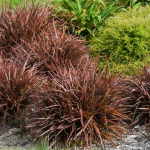
Phormium Bronze Gem is one of the most compact dwarf flaxes with beautiful bronze foliage providing colour all year round.
Phormium cookianum (Wharariki, Mountain Flax)
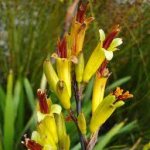
Phormium cookianum, Wharariki, is commonly called Mountain Flax, is a superb species, one of the hardiest and the most striking. Long arching green leaves all year round, and 2 metre long flower stalks over summer - particularly attractive to native birds. Use as a 'groundbreaker' in new gardens, en masse on banks. Foliage and flowers are great for floral artwork.
Phormium cookianum is a flax up to 1-3 metres tall but generally smaller than Phormium tenax. The numerous leaves are 5-12cm wide, thick, fibrous, droopy, and rise from fan-like bases. The tubular 25-40 mm long flowers are a dull pink or yellow colour. The seed capsule is pendulous and twisted.
Habitat: Strictly confined to subalpine, alpine situations, where it mainly grows on cliffs and mountain slopes, in seepages, along stream sides or on the margins of bogs.
Flowering: Spring [November - December]
Fruiting: Summer [January - March]
Phormium cookianum Purpurea (Purple Mountain Flax)
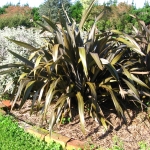
Phormium cookianum Purpurea is a red foliaged variety of the Mountain Flax. Flower spikes rise above the plant and bear twisted looking flowers, to which birds are attracted for the nectar. Curiously, many of the red varieties don't flower, however the purples, greens and yellows do.
Flowering: Spring [October - December]
Fruiting: Summer [January - March]
Phormium Cream Delight (Cream Flax)
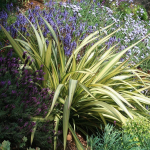
Phormium Cream Delight is a medium-height flax with striking cream and yellow foliage. Cream Delight has a tidy weeping form, ideal as a contrast plant in the garden. Easy to grow in just about any position you desire however will look its best with protection from harsh afternoon sun. Groom to keep tidy. Evergreen. Hardy.
Phormium Dark Delight (Dark Purple Flax)
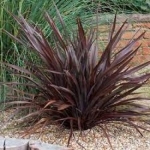 Sold Out
Sold Out
Phormium Dark Delight is a beautiful medium sized flax with the deepest wine coloured, sword shaped foliage. Easy to grow in just about any position you desire however will look its best with protection from harsh afternoon sun. Groom to keep tidy. Evergreen.
Phormium Emerald Gem (Dwarf Green Flax)
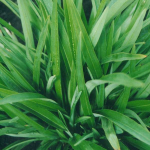
Phormium cookianum Emerald Gem is very popular for amenity planting, as it is smaller growing than Phormium cookianum. This dwarf variety of Flax produces narrow, sword like leaves that are a striking emerald green colour. Through summer it produces yellow flowers on tall stems that attract all manner of birds. This variety typically grows to 60 cm tall and 70 cm wide with a tidy and compact habit. Emerald Gem is a versatile plant that makes a fantastic addition to mixed plantings and borders, using in coastal gardens, planting to accentuate water features such as ponds and streams, or growing around pool and barbecue areas. It is also well suited for mass planting on a bank and in these situations provides an impressive display.
It performs best when planted in full sun on a well-drained site though it will tolerate frost, coastal conditions, wind, poor soils, moderate shade, and cool climates.
Flowering: Spring [October - December]
Fruiting: Summer [January - March]
Phormium Golden Ray
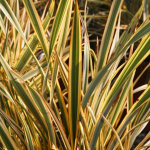
Phormium Golden Ray has upright to semi-arching leaves which have a broad mid green central band surrounded with creamy yellow stripes. Plant in full sun to light shade. Can tolerate fairly dry conditions, but looks best with occasional to regular water. Easy to grow in just about any position you desire however will look its best with protection from harsh afternoon sun. Groom to keep tidy. Evergreen.
Phormium Jester
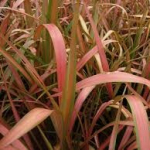 Sold Out
Sold Out
Phormium Jester is a fabulous flax that has won much admiration both in NZ and world wide. The bright pink arching leaves are edged attractively in green. Looks stunning group planted. Easy to grow in just about any position you desire however will look its best with protection from harsh afternoon sun. Groom to keep tidy. Evergreen
Phormium Pepe (Dwarf Green Flax)
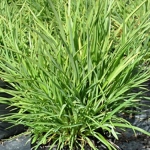
Phormium Pepe is a dwarf green flax. A very hardy plant, erect habit flowers in late spring. Tolerates dry or moist situations. Great in rockeries.
Phormium Pepe Purpurea (Dwarf Purple Flax)
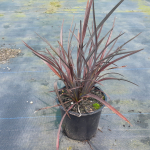 Sold Out
Sold Out
Phormium Pepe Purpurea is a dwarf purple flax. A very hardy plant, erect habit flowers in late spring. Tolerates dry or moist situations great in rockeries.
Phormium Surfer Bronze (Dwarf Bronze Flax)
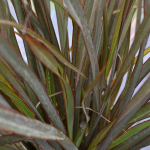
Phormium Surfer Bronze is a very dwarf bronze flax with strong form. Clumps freely to make a good strong cover with striking texture. Mass plant for best effect. Fantastic in a rock garden, or with stone mulch, most suitable dry position, withstands extreme cold, alpine, windy or coastal conditions.
Phormium Surfer Green (Dwarf Green Flax)
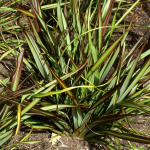
Phormium Surfer is an excellent compact dwarf flax, producing olive green weeping leaves with bronze margins. Excellent all round landscaping specimen growing anywhere from damp to dry conditions. Withstands strong coastal winds and frost hardy.
Phormium tenax (Harakeke, Swamp Flax)
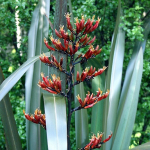
Phormium tenax, Harakeke, commonly called Swamp Flax, is one of the oldest plant species in New Zealand and it is unique to New Zealand. With its sword-shaped leaves it is a common feature of the New Zealand landscape. It grows up to 2 -3 metres high and its flower stalks can reach up to 4 metres. The flowers are brownish red in Summer, followed by black seed pods that stand upright from the stems. It is very hardy and fast growing with wide environmental tolerances. It will grow in dry and wet conditions, withstand strong and coastal winds and are frost hardy. It is used for hedging or shelter and in mixed native planting. It is also a pioneer plant meaning it should be one of the species planted first in a restoration planting plan as it establishes quickly when planted and shelters other plants.
Plant communities that include Apodasmia similis, Carex maorica, Carex secta, Carex virgata, and Eleocharis acuta often contain Phormium tenax.
History of use: Traditional uses of flax No fibre plant was more important to Maori than flax. Each pa or marae typically had a pa harakeke or flax plantation. Different varieties were specially grown for their strength, softness, colour and fibre content. Traditionally when harakeke leaves were removed from the plant, only the older leaves on the outside were taken. It is believed the three inner layers of the plant represented a family. This outer layer represented the grandparents, whereas the inner layer of new shoots or the child remained to be protected by the next inner layer of leaves, the parents. The uses of the flax fibre were numerous and varied. Clothing, mats, plates to eat off, baskets, ropes, bird snares, lashings, fishing lines and nets were all made from flax. Babies were even given rattles made from flax. Other parts of the plant were also used. Floats or rafts were made out of bundles of dried flower stalks (kokari). The abundant nectar from flax flowers was used to sweeten food and beverages. Flax also had many medicinal uses. The sticky sap or gum that flax produces was applied to boils and wounds and used for toothache. Flax leaves were used in binding broken bones and matted leaves were used as dressings. Flax root juice was routinely applied to wounds as a disinfectant. Today, flax is used in soaps, hand crèmes, shampoos and a range of other cosmetics. Flax seed oil can also be found for sale.
Habitat: Common from lowland and coastal areas to montane forest, usually but not exclusively, in wetlands and in open ground along riversides.
Flowering: Summer [November - December]
Fruiting: Summer [January - April]
My Lists: Erosion Control, Wetland, Pioneer Species
Phormium tenax Purpurea (Purple Swamp Flax)
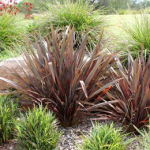
Phormium tenax Purpurea is a red/purple foliaged seedling form of P. tenax, so there is some attractive variation between plants. Generally smaller in stature than the green form. A strong-growing flax forming a red/purple clump. Plant next to shrubs with lighter colouring for best effect.
Flowering: Spring [October - December]
Fruiting: Summer [January - March]
Phormium Tricolour
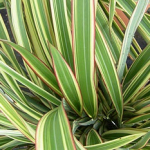
Phormium Tricolour is a strong growing variegated flax. Green and yellow striped leaves with a red pin-stripe edge. Easy to grow in just about any position you desire however will look its best with protection from harsh afternoon sun. Groom to keep tidy. Evergreen
Photinia Red Robin (Photinia)
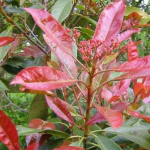
Photinia Red Robin is a popular evergreen shrub with glossy green leaves, white flowers in flattened flowerheads and young red shoots. The best known of the photinias is Photinia Red Robin which is often planted as a specimen shrub or as a fast-growing, dense, evergreen hedge. This shrub offers brilliant new growth of crimson-red and small white flowers in spring. Prune in winter to keep plant bushy and compact. Plant in full sun. Evergreen.
Flowering: Spring [September - November]
Fruiting:
Pimelea declivis
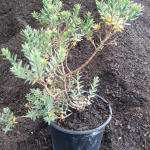
Pimelea declivis is a small blue-green erect shrub native to Canterbury. Inhabiting limestone outcrops from south Marlborough to south Canterbury.
Habitat: Lowland to lower montane, Mostly found in sparse grassland and grey scrub associated with limestone ridges, scarps, cliffs, outcrops, screes and boulder heaps.
Flowering: Spring - Summer [October - May]
Fruiting: Summer - Autumn [November - May]
My Lists: Rare Plants
Pimelea prostrata (Pinatoro, NZ Daphne)
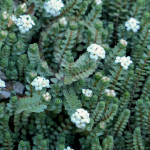
Pimelea prostrata, Pinatoro, or NZ Daphne, is a native groundcover with an attractive low growing plant with white flowers. It flowers prolifically over the summer months and is followed by small clear, white berries. The outstanding blue green foliage is a stand out with this groundcover. Is best grown in a free-draining soil in a full sun position. Excellent for sunny banks or rockeries.
Habitat: Coastal to montane. In open sites, such as coastal gravel, sand dunes, grasslands and mudstone cliffs.
Flowering: Spring - Autumn [September - May]
Fruiting: Winter [October - July]
Pimelea prostrata Blue Peter
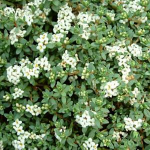
Pimelea Blue Peter is a hardy coastal groundcover with compact tiny pointed blue-grey foliage and white starry flowers all summer. A low growing plant with a very free flowering habit. Attractive hanging over walls, use in a pot as a feature or for underplanting. Excellent as a trouble-free mass planting.
Flowering: Summer [December - February]
Fruiting: Winter [June - August]
Pittosporum eugenioides (Tarata, Lemonwood)
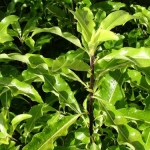
Pittosporum eugenioides, Tarata, commonly called Lemonwood, is a bushy tree ideal as a specimen or for hedging. Lemon scented foliage and fragrant flowers (spring).
Great in a windy position and also provides a barrier for the surrounding more intolerant plants. Pittosporums can be excellent stand-alone features, hedges, screens, windbreaks, shrubberies or topiary specimens. The highly ornamental, evergreen foliage almost always looks well-groomed and responds well to pruning. Frost tender when very young. Prefers a sunny to part shade position, does not mind the wind, and thrives in soil with good drainage. Tarata is somewhat drought-resistant therefore rainfall is not a major factor in its survival.
It has proved to be a great plant for establishing a quick canopy in a restoration project. It then provides an opportunity to introduce understory, shade loving plants to the same location, later planting underneath the lemonwood trees. Lemonwood is on the recommended list for replanting “small trees up to 6m.”
History of use: Maori used the gum from the bark in complex scent formula along with parts of other plants.
Habitat: Common tree of regenerating and mature forest in coastal to montane situations. It is found in forest clearings and along forest margins up to 600m above sea level.
Flowering: Spring [October - December]
Fruiting: Autumn [March - June]
My Lists: Erosion Control
Pittosporum Mountain Green
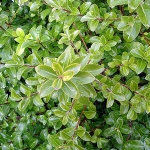 Sold Out
Sold Out
Pittosporum Mountain Green is a native evergreen that is fast becoming fashionable for its hedging and bordering appearance. With its dense glossy, lime green foliage, it offers a neutral and maintenance-free back drop to many planting plans. Best in a warm, full sun position. Evergreen. Hardy.
Flowering: Spring [September - November]
Fruiting:
Pittosporum obcordatum (Heart-leaved Kohuhu)
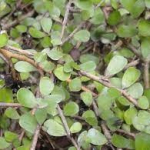 Sold Out
Sold Out
Pittosporum obcordatum is a rare, tall column shaped tree native to New Zealand. Naturally grows throughout New Zealand most commonly in eastern lowland alluvial forest favouring sites that are prone to summer drought in order to avoid water logged soils. It gets its column form form the dense interlaced twigs and branchlets that completely cover the trunk. The species has many small rounded leaves and produces small red, pink and yellow fragrant flowers in late spring. Does best in moist, fertile soil in semi-shade.
Habitat: A species of primarily eastern lowland alluvial forest, favouring sites prone to summer drought being otherwise waterlogged, and frost-prone during winter.
Flowering: Spring [September - December]
Fruiting: Summer [December - May]
My Lists: Rare Plants
Pittosporum Pixie (Dwarf Pittosporum)

Pittosporum Pixie is a dense round shrub with a distinctive form. The miniature leaves are silvery grey with wavy margins. Great as a feature shaped round like a golf ball or as a hedge. Very dark maroon, almost black flowers in spring. Hardy to most soil conditions, avoid wet ground. Will always look its best in good soil. Frost and wind hardy. Best to trim annually to maintain shape and encourage fresh new foliage.
Flowering: Spring [September - November]
Fruiting:
Pittosporum Stephens Island
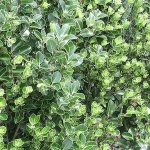
Pittosporum Stephens Island is an attractive, large growing, hardy evergreen with lime to olive green leaves. Due to its neutral colour and texture, it provides a fabulous background for many garden designs and styles. This plant maintains a neat habit, is quick growing and ideal for screening out unwanted views, noise or wind. Plant in fertile, moist but well-drained soil. Protect in colder areas from cold, drying winds. Can be planted in sun or partial shade, although leaf colour is best in sun. Evergreen. Hardy.
Pittosporum 'Stephens Island' is a form found growing on Stephens Island in the middle of Cook Strait. It has some resemblance to both Pittosporum tenuifolium and Pittosporum crassifolium (or may be a naturally occurring hybrid between P. tenuifolium and P. ralphii). It has a tidy habit with and upright medium form and will grow to a mature height of 5-10m. The small pointed foliage is smooth, blue/grey-green with a slight grey/green tomentose appearance. It adapts well to coastal conditions.
Flowering: Spring [September - November]
Fruiting:
Notice: Taking orders now for summer delivery
Pittosporum tenuifolium (Kohuhu, Black Matipo)
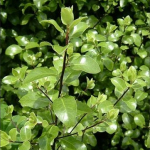
Pittosporum tenuifolium, Kohuhu, commonly called Black Matipo, is endemic and widespread throughout New Zealand. It is an extremely popular, adaptable and fast growing. Shiny light-green foliage with wavy margins and reddish brown branchlets. Fragrant dark red flowers in spring. Excellent plant for hedging and shelter. Tolerates wind, drought, frost, coastal conditions. A key species for forest revegetation and also a useful riparian edge plant. Kōhūhū grows particularly quickly at forest edges located at the bottom of high terraces. Sun or shade. Hardy. Evergreen.
The flowers’ colour ranges from dark-red to dark-purple turning almost black as the flowers age. Nectar fills the flowers. The flowers exude a honey-scented fragrance in the evenings with the scent being more obvious in slightly damp conditions. This attracts moths and night-flying insects, New Zealand’s indigenous pollinators. Fertilised flowers develop into small fruits that blacken as they ripen.
Habitat: A small tree of coastal to montane shrubland and forested habitats. Preferring successional habitats.
Flowering: Spring - Summer [October - January]
Fruiting: Autumn [February - June]
My Lists: Erosion Control
Plagianthus divaricatus (Makaka, Salt Marsh Ribbonwood)
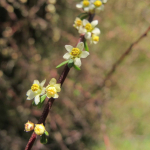
Plagianthus divaricatus, commonly called Salt Marsh Ribbonwood, is a dense twiggy shrub with small narrow leaves. Small sweetly scented flowers. Good hedging, deciduous, cold hardy. Will tolerate salt winds and wet soils. It can be found in association with (but not limited to) Coprosma propinqua, Muehlenbeckia complexa, Cyperus ustulatus, and Phormium tenax.
Found in sheltered coastal shorelines throughout New Zealand, in areas with salt swamp, sandy banks and throughout estuaries. As its common name suggests, it is salt and wet tolerant. As with P. regius, it has a juvenile and adult form where the leaves become larger as it grows. Used as a coastal wetland and restoration plant.
Habitat: Found alongside salty swamps or damp gravelly places in coastal regions.
Flowering: Spring [September - November]
Fruiting: Summer [December - March]
My Lists: Erosion Control, Wetland
Plagianthus regius (Manatu, Lowland Ribbonwood)
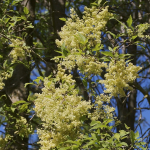
Plagianthus regius, Manatu, or Lowland Ribbonwood is a deciduous tree grown for its foliage and flowers. A profusion of small white or green flowers appears in large panicles in spring making it easier to distinguish from the similar lacebark.
Like many New Zealand native Plagianthus regius has a juvenile form that becomes a straight trunked medium to large tree. The juvenile form has bushy interlacing branches with small leaves, while an older tree will tend to have larger leaves, sometimes with the lower parts of the tree still displaying divaricating leaves.
Habitat: Coastal to lower montane. Often a prominent tree in lowland alluvial forest.
Flowering: Spring [September - November]
Fruiting: [December - January]
My Lists: Erosion Control
Poa cita (Wi, Silver Tussock)
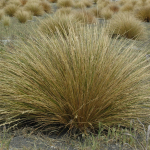
Poa cita, Wi, or Silver Tussock, is a densely tufted tussock of a graceful habit. Fine shiny silvery-green erect foliage with a flowing habit. Slender flowering stem, tawny coloured. Best in poor dry soils in an open situation. Excellent for mass planting. Great for exposed windy sites.
Habitat: Preferring a full sun position, tolerant of light shade, coastal conditions, and drought. Poa cita is often found in dry woodland and grassland plant communities
Flowering: Summer [November - December]
Fruiting: Summer [January - February]
My Lists: Pioneer Species
Podocarpus nivalis (Snow Totara)
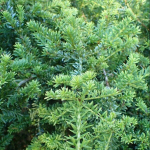
Podocarpus nivalis, commonly called Snow Totara, is a low growing, almost prostrate shrub found in sub alpine parts of New Zealand, although can grow at low altitude as well. It has small leathery olive-green leaves and edible red berries in the autumn. Fantastic option for a trimmed low hedge.
Habitat: Montane to alpine. Common in open tussock grassland and subalpine scrub.
Flowering: Spring [September - November]
Fruiting: Autumn [December - June]
Podocarpus totara (Totara)
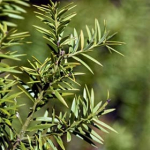
Podocarpus totara, is a classic NZ Native with needle like leaves, olive green, orange-red fruit. Bark red / brown, good shaped tree with durable timber. Tolerates wide range of sites. Evergreen. Frost tender when young.
Commonly known as Totara, trees are either male or female with the female trees having bright red, berry-like fruit in autumn. Male trees do not bear fruit. It grows with a broad and spreading habit to eventually reach 20 m tall and 10 m wide, and can be included in a medium sized garden due to its slow growth rate. Best results with this tree are achieved when it is grown in full sun on a well-drained site. It is tolerant of mild drought, frost, cool climates, some wind, and coastal environments. Totara is commonly included in a mixed planting in a large garden, used in native plantings, or grown as a specimen.
Habitat: Widespread and at times abundant tree of lowland, montane and lower subalpine forest. May also form a vegetation type in which it is the dominant species.
Flowering: Spring [October]
Fruiting: Autumn [March - May]
Prunus lusitanica (Portuguese Laurel)
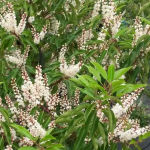
Prunus lusitanica, commonly called Portuguese Laurel, is a hardy and versatile evergreen shrub with smooth dark green leaves. Portuguese Laurel produces slender white flower racemes late spring and summer. It creates an excellent formal hedge or screen. Tolerates a wide range of conditions from dry to frosty areas. Poisonous to animals. Evergreen. Cold and drought hardy.
Flowering: Spring [September - November]
Fruiting: Summer [December - January]
Pseudopanax arboreus (Whauwhaupaku, Fivefinger)
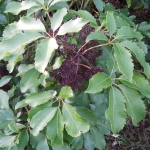
Pseudopanax arboreus, commonly called Fivefinger, is one of New Zealand's most common native trees found from Cape Reinga to Bluff in lowland forests. Its particular form of a glossy, five to seven fingered leaf along with quick and luxuriant growth. It grows into a small stout tree up to 5 metres high and grows well in most soils and situations. Fast growing with small purplish black berries in autumn.
History of use: New Zealand Beekeepers Magazine rates Pseudopanax arboreus as a star performer for food for bees. The trees provide abundant pollen and copious, rich nectar very early in the season when few other species are in flower (from June to August). Plant in good numbers clustered together to amplify the availability of flowers for bee feed. Bees love the small scented green flowers that are followed by bunches of dark purple fruits enjoyed by birds from August to February. Flower buds can be easily mistaken for ripe fruit whereas clusters of fruit are actually ripe one year after flowering.
Habitat: Coastal to montane. Moist broadleaf forest. Frequently epiphytic. A frequent component of secondary forest and forest margins. Tolerant of moderate frosts and coastal conditions but should be sheltered from strong winds.
Flowering: Winter [June - August]
Fruiting: Spring - Summer [August - February]
My Lists: Winter Pollen
Pseudopanax crassifolius (Horoeka, Lancewood)
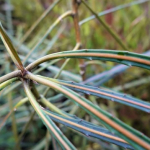
Pseudopanax crassifolius, commonly known as Lancewood or Horoeka, is a species of evergreen tree that is native to New Zealand. It belongs to the family Araliaceae and is known for its unique growth habit and distinctive foliage.
Lancewood typically grows to a height of 3 to 10 meters, though it can reach up to 15 meters in favorable conditions. It has a slender, erect trunk that is often unbranched for several meters, giving it a distinctive lance-like appearance. The trunk is smooth and grayish-brown in color, and it is often marked with vertical ridges or scars from fallen leaves.
The leaves of Pseudopanax crassifolius are leathery and glossy, with a lanceolate shape that tapers to a point. They are typically dark green in color and can measure up to 60 centimeters in length. The margins of the leaves are serrated or toothed, which adds to their distinctive appearance.
One of the most striking features of Pseudopanax crassifolius is its ability to change its leaf shape as it matures. Young Lancewood trees have long, narrow leaves with serrated margins, while older trees develop larger, broader leaves with smooth margins. This unique leaf morphology has earned it the nickname "lancewood" due to its resemblance to a lance or spear.
Pseudopanax crassifolius produces small, inconspicuous flowers that are typically green or cream-colored. The flowers are arranged in clusters and are followed by small, fleshy fruit that ripens to a dark purple or black color. The fruit is an important food source for native birds in New Zealand.
Lancewood is a hardy plant that is well-adapted to New Zealand's coastal and lowland forests. It can tolerate a wide range of soil types, but prefers well-drained soils. It is a slow-growing species and can take many years to reach maturity.
In addition to its unique appearance, Pseudopanax crassifolius has cultural significance for the Māori people of New Zealand, who have traditionally used its wood for various purposes, including weapons, tools, and construction. Today, it is also a popular ornamental plant in gardens and landscapes, prized for its distinctive foliage and architectural form.
Habitat: Lowland to montane forest. Sealevel to 750 m
Flowering: Summer - Autumn [January - April]
Fruiting: Autumn [January - April]
My Lists: Pioneer Species
Pseudopanax ferox (Horoeka, Toothed Lancewood)
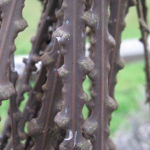
Pseudopanax ferox, Toothed or Fierce Lancewood, is a spectacular slow-growing specimen with narrow, down pointing saw-like brown very tough juvenile leaves that have irregular blunt bumps along the edge. Once the slow-growing tree reaches maturity at 10 to 15 years, the leaf form becomes shorter, wider and dark green in colour. It is only in adulthood that the tree's shape changes from one central stem and has downward growing leaves to a more typical tree shape with branches spreading to build a round head. A mature toothed lancewood can reach 6 metres height with a trunk of up to 25 cm in diameter.
Habitat: Coastal to subalpine (10-800 m a.s.l.) on consolidated sand dunes (dune forest), in grey scrub overlying pumice, on recent alluvial (coarse gravels), limestone outcrops, boulder fall, cliff faces, talus slopes and scarps. Also found as a sparse component of seasonally drought-prone but otherwise cold and wet alluvial forests. This species prefers drier habitats and conditions than P. crassifolius.
Flowering: Summer [November - April]
Fruiting: Autumn [December - June]
Pseudowintera colorata (Horopito, Pepper Tree)
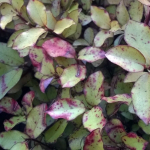 Sold Out
Sold Out
Pseudowintera colorata is endemic and found throughout the country in coastal to montane areas. It is often found in heavily browsed forests and therefore not threatened. Unpalatable to browsers due to its peppery leaves. Pseudowintera colorata is evergreen and likes moist soil rich in organic matter.
Habitat: Coastal, lowland, or montane forest margins and shrubland.
Flowering: Summer [November - March]
Fruiting: Autumn [December - June]
Raoulia hookeri (Golden Scabweed)
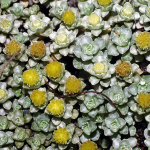
Raoulia hookeri is a small, mat-forming evergreen perennial with tiny, rosettes of silver, spoon-shaped leaves. Excellent in the rock garden.
The genus Raoulia is named after Étienne Fiacre Louis Raoul (23 July 1815–30 March 1852) who was a French naval surgeon and naturalist. On the ship L’Aube who was in Akaroa in 1840-41. He published a book Choix de plantes de la Nouvelle-Zélande ("Selected plants of New Zealand") in 1846. The genus was named after him by Joseph Hooker.
The Species hookeri is named after Sir Joseph Dalton Hooker (born 1817) a world famous botanist who travelled on the Antarctic expedition of 1839 under the command of Sir James Ross and wrote "Handbook of New Zealand Flora" published in 1864-67 describing many specimens sent to Kew by collectors. He died in 1911 and has a memorial stone at Westminster Abbey London.
Habitat: Dense mat forming plants found covering stone-strewn dry river and stream beds. Found in alpine dry rocky places and screes.
Flowering: Summer [December - January]
Fruiting:
Rosmarinus prostratus (Creeping Rosemary)
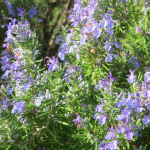
Rosmarinus prostratus, Prostrate Rosemary, or Creeping Rosemary, is a low-spreading, evergreen shrub or groundcover. Its leaves are green, leathery and very aromatic. This Creeping Rosemary has pale-blue flowers from early to mid-summer. Rosmarinus officinalis Prostratus can be used as a beautiful groundcover because of its height which reaches only up to 30cm and 150cm in its spread. Creeping Rosemary will trail over walls or edge of a raised bed to make a curtain like effect.
Culinary herb and many medicinal uses. This herb, especially the flower tops, contains antibacterial and antioxidant rosmarinic acid, plus several essential oils such as cineol, camphene, borneol, bornyl acetate, and α-pinene that are known to have anti-inflammatory, anti-fungal, and antiseptic properties. Many sources document rosemay’s effect on improving memory, slightly fewer mention its ability to attract lovers, and repel nightmares! Use woody stems as skewers on BBQ to impart flavour. Very drought tolerant. Full sun.
Flowering: Summer - Autumn [December - May]
Fruiting:
Rosmarinus Tuscan Blue (Upright Rosemary)
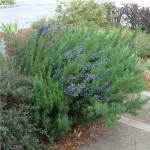
Rosmarinus Tuscan Blue is a large evergreen, upright Rosemary with a good flavor making it an excellent culinary herb, or a landscaping shrub. As an herb, Rosemary is used to flavor meat dishes, and condiments. The small blue flowers that appear in mid summer are edible as well, and make a nice garnish for salads. In the landscape Rosemary is used in hot, sunny locations as it is very drought resistant and withstands the heat and humidity well.
Many sources document rosemary’s effect on improving memory, slightly fewer mention its ability to attract lovers, and repel nightmares! A lovely children’s herb for this folklore reason but also due to its lingering scent, and its ability to take quite a battering from constant harvest for teas and ‘potions’.
The woody stems can also be used as skewers on the BBQ to impart flavour. Very drought tolerant. Full sun. Height to 2m.
Flowering: Spring - Summer [September - March]
Fruiting:
Santolina chamaecyparissus (Cotton Lavender)
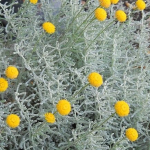
Santolina chamaecyparissus is commonly known as Cotton Lavender, this is a small shrub grown for its foliage and flowers. It produces a dense network of small and aromatic, silver leaves, cypress-like and acts as an insect repellent.. The foliage is adorned with mass of yellow, button-like flowers in summer. Flowers can be used in floral arrangements.
This evergreen grows with a rounded. It performs best when grown in full sun on a well-drained site, noting that is hardy to dry periods, coastal environments, and moderate frost once established. The Cotton Lavender is commonly included in borders, mass planted as a ground cover, maintained in a container, included in cottage or Mediterranean gardens, or planted around outdoor living areas. It is an easy plant to grow and very rewarding. A pretty cottage plant. Cut back after flowering.
Flowering: Summer [December - February]
Fruiting:
Scleranthus biflorus (Canberra Grass)
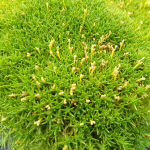
Scleranthus biflorus, commonly known as New Zealand Cushion Plant or Knawel, is a low-growing, mat-forming perennial plant native to New Zealand. It belongs to the Caryophyllaceae family and is known for its distinctive cushion-like growth habit and small, inconspicuous flowers.
The leaves of Scleranthus biflorus are tiny, narrow, and needle-like, with a bright green color. They are arranged in pairs along the stems, giving the plant a unique appearance resembling a dense, mossy cushion or a miniature mossy mound. The leaves are typically evergreen, retaining their green color throughout the year, although they may turn bronze or reddish in cold weather.
The flowers of Scleranthus biflorus are small and inconspicuous, usually greenish or yellowish in color. They are borne on short stalks and are typically solitary, with two flowers per stem, hence the species name "biflorus". The flowers are not the main feature of this plant, as they are often overshadowed by the dense foliage.
Scleranthus biflorus is a hardy plant that is well-adapted to rocky or sandy soils and is often used as a ground cover in rock gardens, alpine gardens, or other low-maintenance landscapes. It is also suitable for planting in crevices or gaps in stone walls or between stepping stones, where its cushion-like growth habit can add a unique and visually appealing touch.
One of the notable characteristics of Scleranthus biflorus is its ability to tolerate dry conditions and periods of drought, making it a good choice for water-wise gardening. It is a relatively low-maintenance plant that requires minimal care, although it may benefit from occasional trimming to maintain its compact form.
Habitat: Coastal
Flowering: Spring [October - December]
Fruiting:
Sempervivum purpurea (Purple Succulent)
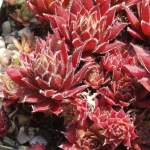
Sempervivum purpurea, or Hens and Chicks grow in a fantastic clump/mat of colorful rosettes. Plants thrive in porous soil with full to part sun. Soil and light conditions can change the look of the varieties drastically. Once established, Sempervivum are drought tolerant.
Sophora microphylla (South Island Kowhai)
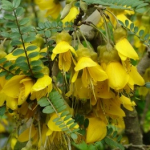
Sophora microphylla is also known as South Island Kōwhai, having showy yellow flowers in early spring. This particular Kōwhai has very small leaves (microphylla) and a tangled juvenile form, tending to straighten up and grow from an upright trunk at about four years. Kōwhai makes a good garden tree and is necessary for revegetation projects as a bird attractor. Kōwhai are suited to upper bank plantings of riparian areas. They also make beautiful shade or specimen trees. Semi-deciduous. Hardy.
Sophora microphylla have horn-shaped yellow flowers. The nectar is a favourite food for Tui, Bellbird and Kererū which also eat the leaves. The seed pods which appear after flowering stay hanging on the tree through winter.
Kōwhai is the national flower of New Zealand.
Habitat: In the North Island, especially the northern half this is a species of mainly riparian forest. South of Hamilton it can be found in a diverse range of habitats from coastal cliff faces and associated wetlands to inland grey scrub communities. Sophora microphylla and Sophora prostrata are the only forms naturally existing in Canterbury.
Flowering: Winter [August - October]
Fruiting: Spring - Summer [October - May]
My Lists: Winter Pollen
Sophora prostrata (Dwarf Kowhai)
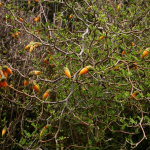 Sold Out
Sold Out
Sophora prostrata, commonly known as Dwarf Kowhai, is a low-growing shrub or small tree species that belongs to the family Fabaceae. It is native to New Zealand and is known for its vibrant yellow flowers and unique, prostrate growth habit.
One of the most distinctive features of Sophora prostrata is its striking yellow flowers, which are pea-like in shape and arranged in clusters at the ends of the branches. The flowers usually appear in late winter or early spring, and their bright yellow color is a standout feature against the dark green foliage. The flowers are attractive to bees and other pollinators.
Sophora prostrata is endemic to New Zealand, where it is found in a variety of habitats including coastal cliffs, sand dunes, shrublands, and forests. It is particularly well-adapted to tolerate salt spray and harsh coastal conditions, which makes it suitable for coastal gardens and landscaping.
Sophora prostrata serves as an important host plant for the caterpillars of several native butterfly species. Additionally, Sophora prostrata is a popular ornamental plant in gardens and landscapes due to its attractive flowers and unique growth habit. Semi-deciduous. Very tough on exposed, cold, dry sites.
Habitat: Found from the coast to subalpine in open rocky planes. Confined to the eastern South Island from Marlborough to the Waitaki Valley.
Flowering: Spring [September - October]
Fruiting: Summer [January - February]
Sophora tetraptera (North Island Kowhai)
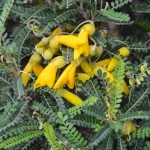
Sophora tetraptera is commonly known as the North Island Kowhai or large-leaved Kowhai that grows naturally only in the central east of the North Island. It has larger, more widely spaced leaves than other species. It is a great specimen to provide some contrast in a strictly native garden with its early abundance of yellow flowers in early spring which are a favourite food of the Tui and other bird life. Frost tender when young,
Habitat: Widespread and common from coastal forested habitats inland along rivers and within associated low scrub and forest. Common around lake margins (especially Lake Taupo) and on ignimbrite cliffs bordering the upper Waikato River. Although a primarily lowland species it can occur in montane riparian forests.
Flowering: Winter - Spring [July - October]
Fruiting: Spring - Summer [October - May]
Teucrium chamaedrys (Wall Germander)
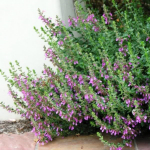
Teucrium chamaedrys, commonly called Wall Germander, is a evergreen subshrub grown for its attractive, dark green aromatic foliage and its light pink to deep purple flowers, which blossom in summer and early fall. This garden workhorse can be used in troughs, containers, low hedges, knot gardens, rock gardens, or as edging.
Flowering: Summer [November - March]
Fruiting:
Teucrium fruticans (Silver Germander)
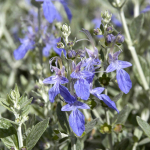
Teucrium fruticans, commonly called Silver Germander, is a hardy and fast growing with lavender-blue flowers. Plant in a hot, sunny area of the garden. Doesn't like wet feet. Clip regularly to maintain a formal hedge. When it gets woody it can be trimmed to ground level to rejuvenate the plant. Handles dry, coastal conditions but responds to summer watering. Contrast plant against dark backgrounds. Useful as both a formal or informal hedge and for topiary.
Flowering: Summer [November - January]
Fruiting:
Thuja occidentalis Smaragd (Emerald Cedar)
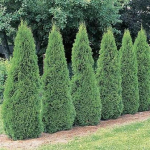
Thuja occidentalis Smaragd, commonly known as Emerald Green Arborvitae, is a cultivar of Thuja occidentalis, a coniferous evergreen tree from the family Cupressaceae. Smaragd is a popular and widely cultivated cultivar known for its distinct appearance and landscaping uses.
Smaragd is a compact, slow-growing evergreen tree that has a narrow, columnar shape with dense branching, forming a symmetrical, pyramid-like silhouette. The foliage is arranged in flattened sprays that are scale-like and tightly packed, giving the tree a fine-textured, feathery appearance.
The foliage of Smaragd is its most distinctive feature. The scale-like leaves are emerald green in color, hence the cultivar name "Smaragd," which means "emerald" in German. The foliage retains its color throughout the year, providing year-round interest in the landscape. When crushed, the leaves release a pleasant aroma.
Smaragd produces small, inconspicuous cones that are about 0.5 inches (1.3 cm) long and initially green, but turn brown as they mature. The cones are typically hidden deep within the foliage and are not a prominent feature of the tree.
Smaragd has a slow to moderate growth rate, making it relatively low-maintenance compared to other evergreen trees. It prefers full sun to partial shade and well-drained, moist soil. Once established, it is drought-tolerant and can withstand a wide range of soil conditions. Smaragd is generally resistant to pests and diseases, although it may be susceptible to some fungal diseases in humid conditions.
Due to its compact size, narrow form, and attractive emerald green foliage, Smaragd is a popular choice for hedges, screens, and foundation plantings. It can also be used as a focal point in small gardens, rock gardens, or as a specimen tree in larger landscapes. Smaragd is commonly used in urban and suburban landscapes for its year-round green color and low-maintenance requirements.
Overall, Thuja occidentalis Smaragd is a versatile, slow-growing evergreen tree with a distinctive emerald green foliage, making it a popular choice for landscaping projects where a compact, columnar form and year-round green color are desired. Evergreen. Hardy.
Notice: Taking orders now for summer delivery
Veronica albicans (Hebe albicans)
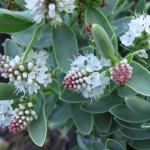
Veronica albicans, used to be called Hebe albicans, is a compact hebe with wonderful grey foliage has a neat habit ideal for rockeries and containers. Popular with landscapers. Small white flowers are borne in profusion during summer. Light prune and feed after flowering to maintain shape.
Habitat: It grows in a range of habitats from just above sea-level to subalpine situations.
Flowering: Summer: [December - January]
Fruiting:
Veronica buchananii (Hebe buchananii)
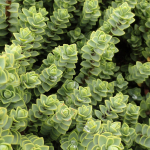
Veronica buchananii, used to be called Hebe buchananii, is a tiny glaucous leaved plant with white flowers, compact and low growing. It is closely related to Hebe pinguifolia.
Habitat: Open penalpine/subalpine areas on rocks, debris slopes, in low shrubland, or sometimes in grassland.
Flowering: Summer [December - March]
Fruiting:
Veronica decumbens (Hebe decumbens)
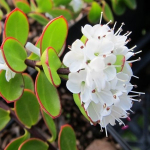
Veronica decumbens, formerly known as Hebe decumbens, is native to the North Canterbury region, has shiny dark green leaves with a red margin. Bears tiny white flowers from late spring to summer.
Habitat: Found among mountains from Nelson to Canterbury on rocky ledges at around 1,000 - 1,400m.
Flowering: Summer [December - February]
Fruiting:
Veronica diosmifolia (Hebe diosmifolia)
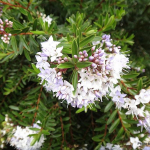
Veronica diosmifolia, formerly known as Hebe diosmifolia, is a rounded bushy shrub with fine erect branches. Short narrow bright green leaves are inclined on one plane and give this dense shrub a very distinctive appearance. The white or lilac flowers smother the bush and appear in spring over a long period. It will grow in sun or semi-shade, best in well drained soil, will grow in dry sites. Hardy to cold. A very tidy plant that clips well, and stays looking great for many years. Occurs naturally in Northland.
Flowering: Spring - Summer [November - February]
Fruiting:
Veronica Emerald Green (Hebe Emerald Green)
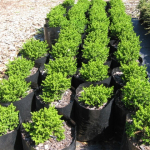
Veronica Emerald Green , formerly known as Hebe Emerald Green, is a small tightly formed glossy green foliage makes for an excellent border Hebe. Can also be mass planted for an instant impact or in pots on the patio or deck. It forms naturally into a ball making it a low maintenance plant. Trim after flowering to promote new growth.
Flowering: Summer [December - February]
Fruiting:
Veronica Icing Sugar (Hebe Icing Sugar)
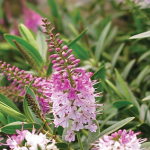
Hebe Icing Sugar is a compact bush with mid-green, spear-shaped leaves with a slight red edge in the cooler months. This shrub flowers mid-late summer and peaks in early autumn. Flower spikes open pink and fade to white, giving a two-tone appearance. Hardy. Evergreen.
Flowering: Summer - Autumn [November - May]
Fruiting:
Veronica Inverey (Hebe Inverey)
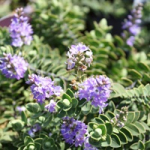
Veronica Inverey, formerly known as Hebe Inverey, is a dense rounded prostrate Hebe with silvery blue foliage and bluish mauve flowers in late spring. Hardy to coastal and exposed conditions.
Flowering: Summer [December - February]
Fruiting:
Veronica odora (Hebe odora, Boxwood Hebe)
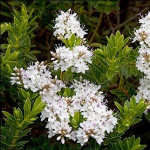
Veronica odora, formerly known as Hebe odora, is a rounded NZ native Hebe has dark green box-like foliage and racemes of white flowers in summer. Can be clipped to maintain a neat shape and makes an attractive hedge. Light prune and feed after flowering to maintain shape and promote new growth.
Habitat: It grows in montane to penalpine grassland, shrubland, bogs and flushes.
Flowering: Summer [October - March]
Fruiting:
Veronica odora Prostrata (Hebe odora Prostrata)
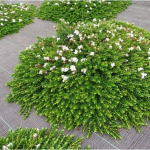
Veronica odora Prostrata, formerly known as Hebe odora Prostrata, is a prostrate form of Hebe odora. Showy, white, cone-shaped flowers. Makes a great addition to native plantings as a ground cover trailing over rocks.
Flowering: Summer [December - February]
Fruiting:
Veronica Oratia Beauty (Hebe Oratia Beauty)
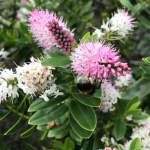
Veronica Oratia Beauty, formerly known as Hebe Oratia Beauty, with pale pink flowers that fade to white. The fleshy leaves are spear-shaped like other Hebes but are broader. Good tidy growth habit. Prefers exposed position in garden.
Flowering: Summer [December - February]
Fruiting:
Veronica Otari Delight (Hebe Otari Delight)
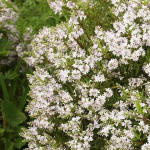
Veronica Otari Delight, formerly know as Hebe Otari Delight, is a rounded bushy shrub with erect branches. Dense narrow bright green leaves. The white to lilac flowers smother the bush and appear in spring over a long period. It will grow in sun or semi-shade, best in well drained soil, will grow in dry sites. Hardy to cold. A very tidy plant that clips well, and stays looking great for many years. Trim after flowering to promote new growth.
Flowering: Spring [December - March]
Fruiting:
Veronica pinguifolia (Hebe pinguifolia)
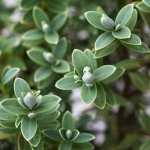 Sold Out
Sold Out
Veronica pinguifolia, formerly known as Hebe pinguifolia, has a neat, low-growing compact shrub with small grey-blue leaves and profuse white flowers.
Habitat: Open alpine areas, on rocks and debris slopes, sometimes in grassland.
Flowering: Summer [December - February]
Fruiting:
Veronica Red Edge (Hebe Red Edge)
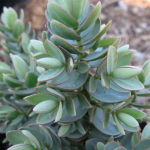
Veronica Red Edge, formerly known as Hebe Red Edge, is a plant that forms a tight dome of grey-green foliage with red margins, which take on a reddish tint in winter. Flowers are pale lilac fading to white in early summer. Trim after flowering to promote new growth.
Flowering: Summer [December - February]
Fruiting:
Veronica salicifolia (Koromiko, Hebe salicifolia)
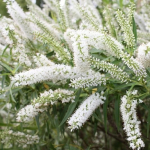
Veronica salicifolia, Koromiko, formerly called Hebe salicifolia, is a fast-growing large, spreading shrub. Provides good low shelter and is an excellent revegetation plant. It has showy white to pale lilac drooping flowers and willow-like foliage. Prefers a moist soil. Trim after flowering in a garden setting.
Veronica salicifolia is a hardy plant but isn’t tolerant of shade and needs to be grown in full sun and in a sheltered area with well-drained soil. It can, however, tolerate wet areas and can often be found on the edge of bush and wetlands. Once established they have considerable drought and frost tolerance.
History of use: The Māori utilized the plant’s medicinal properties for centuries. The leaves were chewed to help cure diarrhoea and applied to the skin to aid ulcers and wounds. Koromiko is the general name for the Hebes in Te Reo and is shared over a range of New Zealand Veronica species.
Habitat: Occurs from sea-level to close to the treeline, mostly in open sites, and forest margins. Is used in lower bank riparian edges where their roots can dry between rain events, but the soil stays damp.
Flowering: Summer [December - May]
Fruiting: Autumn [January - June]
My Lists: Pioneer Species
Veronica salicifolia Snowdrift (Hebe salicifolia Snowdrift)
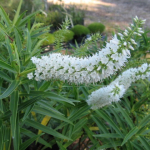
Veronica salicifolia Snowdrift, formerly know Hebe salicifolia Snowdrift, has white flowers appear through the summer. A larger growing shrub that looks good throughout the year. The olive green leaves are long and narrow. Trim after flowering to promote new growth.
Flowering: Summer [December - February]
Fruiting:
Veronica speciosa Blue (Hebe speciosa Blue)
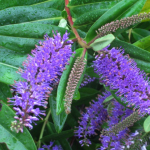 Sold Out
Sold Out
Veronica speciosa Blue, formerly known as Hebe speciosa Blue, is one of the most vigorous of the hebe cultivars and requires regular pruning. It is a round bushy shrub with long branches and leaves that are broad fleshy blunt dark green glossy leaves. In summer and autumn it develops long deep blue flower heads which smother the plant. It grows in sun or semi-shade, but best in well drained soil. Grows in exposed and coastal sites.
Flowering: Summer [December - February]
Fruiting:
Veronica speciosa Flame (Hebe speciosa Flame)
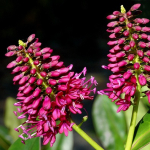
Veronica speciosa Flame, formerly known as Hebe speciosa Flame, has glossy leaves, purple in winter. The leaves are green during summer and turn a bronze purple colour during winter. The leaves have a purple midrib and purple stems. In summer and autumn bright rosy pink flowers. Well suited to mass planting.
Flowering: Summer [December - February]
Fruiting:
Veronica topiaria (Hebe topiaria)
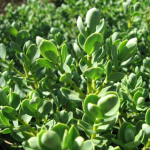
Veronica topiaria, formerly known a Hebe topiara, is a neat, low-growing compact shrub with small grey-blue leaves, profuse white flowers.
Habitat: It grows in shrubland and tussock grassland above the treeline. It can be one of the dominant species in some shrubland associations.
Flowering: Summer [December - February]
Fruiting:
Veronica traversii (Hebe traversii)
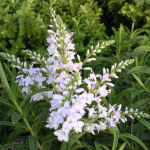
Veronica traversii, formerly known as Hebe traversii, is an erect bushy shrub with green branchlets. Oblong narrow dull mid green leaves, dull green underneath. The white flowers with red stamans, are long and loose making a great show in spring over a long period. It will grow in sun or semi-shade, best in well drained soil, will grow in dry sites. Hardy to cold. A very tidy plant that clips well, and stays looking great for many years.
Habitat: Grows in scrub and at forest margins, often in river valleys, in situations ranging from near-coastal to montane or subalpine.
Flowering: Summer [January - February]
Fruiting:
Veronica venustula (Hebe venustula)
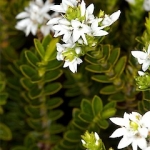
Veronica venustula, formerly known as Hebe venustula, forms a neat, rounded, evergreen bush up to 1 m tall, and more across. The glossy yellow-green leaves, are carried on arching branches. The flowers are white or lilac fading to white, January to February.
Flowering: Summer [January - February]
Fruiting:
Veronica Wiri Mist (Hebe Wiri Mist)
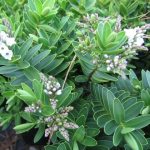
Veronica Wiri Mist, formerly known as Hebe Wiri Mist, is an attractive bush with grey-green foliage and a flat-topped habit. Short spikes of white flowers are produced in abundance in late spring or early summer and it can flower again in autumn.. Trim after flowering to promote new growth.
Flowering: Spring - Summer [October - January]
Fruiting:
Viburnum tinus Eve Price (Viburnum)
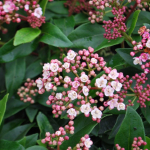
Viburnum tinus 'Eve Price' is a popular evergreen shrub that belongs to the Adoxaceae family. It is a cultivar of the Viburnum tinus species and is known for its dense, compact growth habit and attractive foliage.
The leaves of 'Eve Price' are dark green, glossy, and elliptical in shape, with a leathery texture. They are arranged in opposite pairs along the stems and provide year-round interest due to their evergreen nature. In winter and early spring, 'Eve Price' produces clusters of fragrant flowers that are pinkish-white in color. These flowers are held above the foliage on upright stems and can add a splash of color to the winter landscape. After flowering, 'Eve Price' develops small, metallic-blue berries that mature to black. These berries are a valuable food source for birds and add ornamental interest to the shrub.
Eve Price has a dense, rounded growth habit with a bushy appearance. It is relatively slow-growing and can be easily pruned to maintain its shape and size. 'Eve Price' is known for its hardiness and can tolerate a wide range of growing conditions and is commonly used as a specimen plant, foundation planting, or as a hedge due to its dense growth habit and attractive foliage. It can also be grown in containers and is a good choice for small gardens or urban landscapes.
Flowering: Winter - Spring [June - November]
Fruiting: Autumn [February - April]
Viburnum tinus Lucidum (Viburnum)
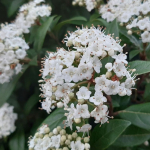
Viburnum tinus 'Lucidum' is a cultivar of Viburnum tinus, a popular evergreen shrub known for its attractive foliage, fragrant flowers, and colorful berries. 'Lucidum' is a variety of Viburnum tinus that is characterized by its glossy, dark green leaves, which are oval in shape and have a leathery texture.
The leaves of Viburnum tinus Lucidum have a lustrous appearance, with a shiny surface that gives them their name "Lucidum," which means glossy or shining. The leaves provide year-round interest, as they remain on the plant throughout the winter, retaining their green color even in colder months.
In addition to its glossy foliage, Viburnum tinus Lucidum produces clusters of small, fragrant flowers in late winter to early spring. The flowers are typically white or pale pink and are borne in rounded clusters known as cymes. The flowers are attractive to pollinators, such as bees and butterflies, and add a splash of color to the winter garden.
After flowering, Viburnum tinus 'Lucidum' produces small, fleshy berries that change color as they mature. Initially green, the berries turn to shades of pink and then eventually to a dark blue-black color. These berries are a valuable food source for birds, adding wildlife interest to the garden.
Viburnum tinus 'Lucidum' is a versatile shrub that can be used in various garden settings, such as mixed borders, hedges, or as a focal point. It is relatively low-maintenance and can tolerate a wide range of growing conditions, including partial to full sun and well-drained soils. It is also fairly drought-tolerant once established. Overall, Viburnum tinus 'Lucidum' is valued for its glossy foliage, fragrant flowers, and attractive berries, making it a popular choice for many gardeners.
Flowering: Winter - Spring [June - November]
Fruiting: Autumn - Winter [February - April]
Westringia fruticosa (Coastal Rosemary)
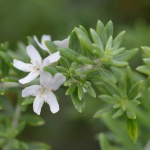 Sold Out
Sold Out
Westringia fruticosa is a hardy fast growing shrub of simple and neat appearance that is easy to grow and long lived. It has grey to dark green foliage and small lightly scented white to palest mauve flowers that bloom throughout most of the year but mainly spring to summer. Westringia fruticosa is useful as a specimen plant or can be used for screening or hedging. The height can be maintained at a lower height if a formal trimmed hedge is required. Idea for coastal planting or areas exposed to wind or other harsh conditions. Will grow in full sun or part shade in most soil conditions and is very salt hardy and drought tolerant once established.
Flowering: Spring - Summer [September - February]
Fruiting:
